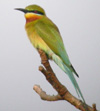INTRODUCTION
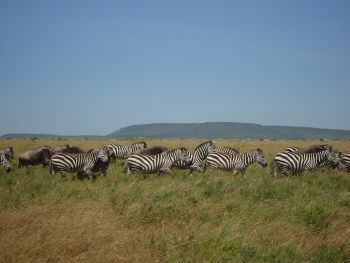 We had been looking at East Africa for a number of years before we decided to take the plunge and head for Tanzania and the iconic locations of the Serengeti plains and the Ngorongoro crater, where both the wildlife and the birds promised great variety and splendour. Having looked at the alternatives we decided to go with our own fully guided private tour and with an itinerary in mind we contacted our old friend Cuan Rush at Rockjumper to set about sorting out accommodation, etc. By virtue of the nature of the trip, it was never going to be cheap, but for a journey of a lifetime, we decided cost was by and large irrelevant: comfort and value for money were the main drivers. Our guide was Wayne Jones who had just completed two back-to-back trips to Tanzania & Kenya for Rockjumper and our driver, Geitan was provided by Rockjumper’s ground agents in Tanzania, Birding & Beyond.
We had been looking at East Africa for a number of years before we decided to take the plunge and head for Tanzania and the iconic locations of the Serengeti plains and the Ngorongoro crater, where both the wildlife and the birds promised great variety and splendour. Having looked at the alternatives we decided to go with our own fully guided private tour and with an itinerary in mind we contacted our old friend Cuan Rush at Rockjumper to set about sorting out accommodation, etc. By virtue of the nature of the trip, it was never going to be cheap, but for a journey of a lifetime, we decided cost was by and large irrelevant: comfort and value for money were the main drivers. Our guide was Wayne Jones who had just completed two back-to-back trips to Tanzania & Kenya for Rockjumper and our driver, Geitan was provided by Rockjumper’s ground agents in Tanzania, Birding & Beyond.
INDEX
Flights
Accommodation
Food
Research and Trip Essentials
Transport
Costs
Weather
Itinerary
Guide
Diary
Summary
Trip List
Bird Photos
Wildlife Photos
Trip Report PDF version
Maps - Northern Tanzania - Tarangire NP 1 & 2 - Ngorongoro CA - Ngorongoro Crater - Serengeti NP
FLIGHTS

 Although we like flying with BA, on this occasion KLM provided the most attractive option as they fly direct from Amsterdam to Kilimanjaro International Airport, leaving us with the shortest flying time out to Tanzania (8½ hours) and no internal flights once we were in Africa. The journey home took a little longer (11 hours) as the KLM route includes Dar es Salaam, before returning to Amsterdam. Travelling from Manchester added 2/3 hours to our overall journey times but, having opted for Business Class, our journeys were tedious but comfortable with all flights leaving almost on time and arrivals always a little ahead of schedule. In recent years airlines seem to have got to grips with managing customer expectations and now make extremely generous allowances in their flying time schedules. We had purchased our Visas in the UK prior to the trip and entry into Tanzania was therefore swift and painless and, flying at the “pointy end” we were one of the first passengers out of the airport. The return trip was not as simple: signage at the small Kilimanjaro airport is almost non-existent and we hadn’t realized we needed to complete an exit form before passing through emigration.
Although we like flying with BA, on this occasion KLM provided the most attractive option as they fly direct from Amsterdam to Kilimanjaro International Airport, leaving us with the shortest flying time out to Tanzania (8½ hours) and no internal flights once we were in Africa. The journey home took a little longer (11 hours) as the KLM route includes Dar es Salaam, before returning to Amsterdam. Travelling from Manchester added 2/3 hours to our overall journey times but, having opted for Business Class, our journeys were tedious but comfortable with all flights leaving almost on time and arrivals always a little ahead of schedule. In recent years airlines seem to have got to grips with managing customer expectations and now make extremely generous allowances in their flying time schedules. We had purchased our Visas in the UK prior to the trip and entry into Tanzania was therefore swift and painless and, flying at the “pointy end” we were one of the first passengers out of the airport. The return trip was not as simple: signage at the small Kilimanjaro airport is almost non-existent and we hadn’t realized we needed to complete an exit form before passing through emigration.
 We were turned back by a surly and rude female official who almost threw our passports back at us. With freshly completed forms we rejoined the queue, passed through emigration and joined the security queue where only one line was being used. Several officials were standing at the head of the queue of waiting passengers and seemed to be arbitrarily holding up the queue whilst at the same time allowing several batches of passengers through; we could only assume their flight departure was imminent and they were late arrivals. Unlike most airports the Business Lounge is situated outside the secure area and when flights begin to board, Business Class passengers are allowed though security with priority. We had been queuing for almost 30 minutes when we sussed this out – we blamed the lack of signage. We left the queue and went to the small lounge where there was little choice of mostly stale food, but at least, a comfortable seat and a reasonable selection of drinks. Kilimanjaro is certainly the worst International Airport we have passed through and not an experience we would wish to repeat. Back to Index
We were turned back by a surly and rude female official who almost threw our passports back at us. With freshly completed forms we rejoined the queue, passed through emigration and joined the security queue where only one line was being used. Several officials were standing at the head of the queue of waiting passengers and seemed to be arbitrarily holding up the queue whilst at the same time allowing several batches of passengers through; we could only assume their flight departure was imminent and they were late arrivals. Unlike most airports the Business Lounge is situated outside the secure area and when flights begin to board, Business Class passengers are allowed though security with priority. We had been queuing for almost 30 minutes when we sussed this out – we blamed the lack of signage. We left the queue and went to the small lounge where there was little choice of mostly stale food, but at least, a comfortable seat and a reasonable selection of drinks. Kilimanjaro is certainly the worst International Airport we have passed through and not an experience we would wish to repeat. Back to Index
ACCOMMODATION
We had asked for 4* accommodation wherever possible and it is against that yardstick judgments are made. For comparison purposes visit Trip Advisor where all the Lodges we stayed at are reviewed to provide a balance to our personal opinions. All Lodges were clean and comfortable (apart from the beds) and provided a prompt laundry service. Apart from Ngare Sero and Kitela Lodge, electricity and hot water were not available 24/7 – times varied, but generally hot water was available from 6-9am and 5-9pm – a little restrictive but manageable.
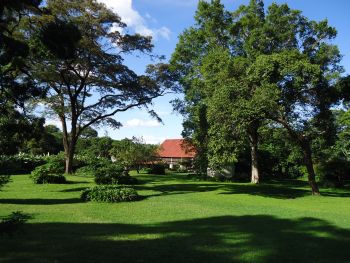 Ngare Sero Lodge Arusha – The taxi from the airport took a little over an hour to reach the Lodge and, having arrived in darkness, the last 30 minutes of the journey down a narrow, dusty, very bumpy track, without any warning that we were heading off into the middle of nowhere, left me feeling a little uneasy in a strange country – Amanda reckons I’m getting soft in my old age! On arrival we were given a warm welcome and shown to our comfortable and spacious room. Much to our dismay the bed was rock hard but we were soon to learn this is the norm in Tanzania. This was one of the few places we stayed that didn’t have mosquito nets, but fortunately we didn’t have any problems with mossies throughout the trip.
Ngare Sero Lodge Arusha – The taxi from the airport took a little over an hour to reach the Lodge and, having arrived in darkness, the last 30 minutes of the journey down a narrow, dusty, very bumpy track, without any warning that we were heading off into the middle of nowhere, left me feeling a little uneasy in a strange country – Amanda reckons I’m getting soft in my old age! On arrival we were given a warm welcome and shown to our comfortable and spacious room. Much to our dismay the bed was rock hard but we were soon to learn this is the norm in Tanzania. This was one of the few places we stayed that didn’t have mosquito nets, but fortunately we didn’t have any problems with mossies throughout the trip.
Tarangire Sopa Lodge – The first of three very comfortable Sopa Lodges we stayed at during our trip. The room was one of the furthest away from Reception and this seemed to be a feature at most of our Lodges: someone must have decided we needed the exercise as we were going to be cooped up in a vehicle for most of the days.
Lake Manyara Wildlife Lodge – The Lodge sits on an escarpment overlooking Lake Manyara and, apart from the Ngorongoro, had the most spectacular view. Reception and all public areas were spacious and welcoming, but the room here was the smallest of the trip and, in comparison to the rest, felt very cramped.
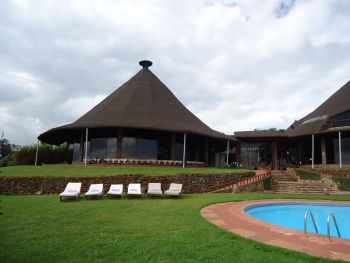 Ngorongoro Sopa Lodge – What a spectacular setting! The lodge sits on the rim of the crater and is conveniently situated near one of the few access roads into the crater. Looking west over the crater ensures stunning sunsets, cloud permitting; an ideal place for a G & T after a hard day birding. Having read a few accounts from people staying here we requested a first floor room, specifically to enjoy a view out over the crater and received confirmation from Rockjumper this was arranged. We were very disappointed to find, once again, we were one of the furthest rooms from Reception, down a steep incline at 2500 metres plus and being on the ground floor, the majority of the crater view was blocked out by cloud forest.
Ngorongoro Sopa Lodge – What a spectacular setting! The lodge sits on the rim of the crater and is conveniently situated near one of the few access roads into the crater. Looking west over the crater ensures stunning sunsets, cloud permitting; an ideal place for a G & T after a hard day birding. Having read a few accounts from people staying here we requested a first floor room, specifically to enjoy a view out over the crater and received confirmation from Rockjumper this was arranged. We were very disappointed to find, once again, we were one of the furthest rooms from Reception, down a steep incline at 2500 metres plus and being on the ground floor, the majority of the crater view was blocked out by cloud forest.
Seronera Wildlife Lodge (central Serengeti) – At around 3pm as we were slowly driving around the Serengeti enjoying the birds and wildlife, we received a phone call from Rockjumper’s local agents advising we would not be staying at the Serengeti Sopa lodge for the next two nights as per the original itinerary, but we should have been staying at the Seronera Wildlife Lodge (two nights at each Lodge had just been reversed). However, the Seronera had overbooked and instead we were to stay at Lobo Wildlife Lodge, about 60/70 kms further north and a long way from our planned birding destinations. After a quick consultation Wayne and Geitan decided it was time to put the foot down and head to the Seronera Wildlife Lodge.
 The wily pair had formulated a plan - with our confirmation of accommodation provided we arrived before 6pm, they proposed to plead ignorance as regards any alternative arrangements and on the basis of first come first served, hoped to secure our rooms as planned (well, almost; as neither Wayne nor ourselves had been advised of the original proposed change to our itinerary). Thankfully, the plan worked as Lobo would have added at least 4 hours to our round trip to the Western Corridor. The hotel was definitely full; we felt sorry for any late arrivals! Seronera was a late addition to our original itinerary as the other preferred alternative was fully booked. Comments on Trip Advisor had left us feeling a little uneasy about coming here: although the rooms are “tired” and in desperate need of a make-over, they were clean and fit for purpose. There were no mosquito nets, but we didn’t have any problems; a pair of Warthogs, hyraxes and baboons wandered freely around outside our room and a mixture of bats enjoyed the flourishing insect life around the exterior lights in the evening. The lodge itself is built around a large Kopje which forms several internal walls and has been used quite imaginatively. There is a raised platform behind the Lodge with spectacular views out over the Serengeti plains and providing an excellent setting for both sunrise and sunsets and a glass (or two) of beer in the evenings. Staff here did not appear to be as friendly or efficient as all the other lodges where we stayed, but surprisingly both breakfast and dinner options were more extensive than most and the food was very good. All-in-all, not as bad as we had been lead to believe, but probably the poorest accommodation of the trip.
The wily pair had formulated a plan - with our confirmation of accommodation provided we arrived before 6pm, they proposed to plead ignorance as regards any alternative arrangements and on the basis of first come first served, hoped to secure our rooms as planned (well, almost; as neither Wayne nor ourselves had been advised of the original proposed change to our itinerary). Thankfully, the plan worked as Lobo would have added at least 4 hours to our round trip to the Western Corridor. The hotel was definitely full; we felt sorry for any late arrivals! Seronera was a late addition to our original itinerary as the other preferred alternative was fully booked. Comments on Trip Advisor had left us feeling a little uneasy about coming here: although the rooms are “tired” and in desperate need of a make-over, they were clean and fit for purpose. There were no mosquito nets, but we didn’t have any problems; a pair of Warthogs, hyraxes and baboons wandered freely around outside our room and a mixture of bats enjoyed the flourishing insect life around the exterior lights in the evening. The lodge itself is built around a large Kopje which forms several internal walls and has been used quite imaginatively. There is a raised platform behind the Lodge with spectacular views out over the Serengeti plains and providing an excellent setting for both sunrise and sunsets and a glass (or two) of beer in the evenings. Staff here did not appear to be as friendly or efficient as all the other lodges where we stayed, but surprisingly both breakfast and dinner options were more extensive than most and the food was very good. All-in-all, not as bad as we had been lead to believe, but probably the poorest accommodation of the trip.
Serengeti Sopa Lodge – After our dash to Seronera, our journey to the Sopa Lodge was quite sedate in comparison, despite the 6km corridor of Tsetse fly infested forest just prior to arriving at the lodge. Thankfully the lodge is situated on a small hillside and the Tsetse fly problem disappears just as you arrive there. As with all the other Sopa Lodges, the rooms were spacious and very comfortable and we enjoyed our stay here.
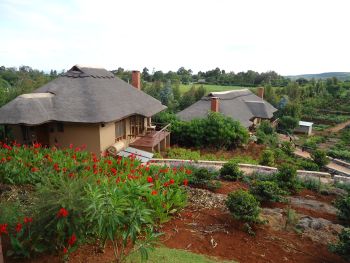 Kitela Lodge – By far the most opulent of our lodges. We were very comfortable here and could have stayed longer, but our trip was drawing to a close. The rooms and facilities were excellent and considering the lodge was only opened in 2012, the grounds and gardens were developing well. Hot water to the cottages is supplied by solar power and the amount of hot water is supposed to be sufficient for two people per cottage. If showers are desirable both afternoon and morning, one of those showers will be in cold water! Food was wonderful.
Kitela Lodge – By far the most opulent of our lodges. We were very comfortable here and could have stayed longer, but our trip was drawing to a close. The rooms and facilities were excellent and considering the lodge was only opened in 2012, the grounds and gardens were developing well. Hot water to the cottages is supplied by solar power and the amount of hot water is supposed to be sufficient for two people per cottage. If showers are desirable both afternoon and morning, one of those showers will be in cold water! Food was wonderful.
Initially we had been scheduled to stay at Gibbs Farm, but renovation work meant the accommodation was unavailable and hence our stay at Kitela Lodge. We did, however, visit Gibbs Farm for lunch and the food was quite easily the best we had tasted in Tanzania. We could happily have stayed here and will, if we return to northern Tanzania. The farm produces a coffee crop and the grounds are generously planted with a huge range of ornamental tropical specimens. Back to Index
FOOD
Good throughout with buffet breakfasts the norm, providing both hot and cold options. Picnic lunches were fairly good in the main, with Lake Manyara Wildlife Lodge providing the most disappointing offering. Do not drink tap water and be careful with home-made fruit juices and raw salads. Back to Index
RESEARCH & TRIP ESSENTIALS

 There are several ID guides but we favour Birds of East Africa: Kenya, Tanzania, Uganda, Rwanda, Burundi
There are several ID guides but we favour Birds of East Africa: Kenya, Tanzania, Uganda, Rwanda, Burundi  by Terry Stevenson and John Fanshawe and Birds of Kenya and Northern Tanzania
by Terry Stevenson and John Fanshawe and Birds of Kenya and Northern Tanzania  by Zimmerman, Turner and Pearson. The Kingdon Pocket Guide to African Mammals
by Zimmerman, Turner and Pearson. The Kingdon Pocket Guide to African Mammals by Jonathan Kingdon is good for identifying the more unusual species. Tanzania (Lonely Planet Country Guides)
by Jonathan Kingdon is good for identifying the more unusual species. Tanzania (Lonely Planet Country Guides) also provides useful background to the country and its people. Trip Advisor also has a quick online guide to the Serengeti.
also provides useful background to the country and its people. Trip Advisor also has a quick online guide to the Serengeti.
Many trip reports can be found online with the best collections at Fatbirder, Surfbirds and Bird Tours. A new trip report portal is now up and running - Cloudbirders: we only found it after our trip, but do give it a go - it appears to do everything Travelling Birder used to do. Back to Index
General hints for travellers to Tanzania.
TRANSPORT
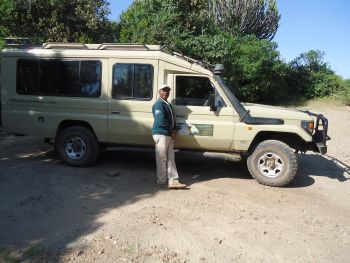 On the first night we were picked up at the airport by a local taxi firm, but thereafter we travelled in a stretched safari Land Cruiser with pop-up roof hatch, which was ideal for birding and wildlife viewing, as most of the time we were in National Parks where you are not allowed to leave the vehicle, other than at designated picnic/camp sites. The Land Cruiser normally seats 8 (including the driver) so we had plenty of room to spread our gear and have clear views from either side of the vehicle. Back to Index
On the first night we were picked up at the airport by a local taxi firm, but thereafter we travelled in a stretched safari Land Cruiser with pop-up roof hatch, which was ideal for birding and wildlife viewing, as most of the time we were in National Parks where you are not allowed to leave the vehicle, other than at designated picnic/camp sites. The Land Cruiser normally seats 8 (including the driver) so we had plenty of room to spread our gear and have clear views from either side of the vehicle. Back to Index
COSTS
US$8225 per person (c£5411 @ June 2013), all inclusive; plus drinks (other than bottled water), laundry, flights, visa fees and medical costs (malaria tablets, yellow fever inoculation etc). A little expensive compared to normal tour party costs, but we wanted to travel by ourselves and decide exactly what we would do on our safari and it was well worth it. Business Class flights with KLM were £2426.50 each - again a bit extravagant, but it was a long journey after all. Visas were £40 each and are only valid for 90 days - something the bear in mind if buying in advance like we did. Back to Index
WEATHER
Although the weather is tropical all year-round, May can be relatively cool with temperatures ranging from 10° to 30°C. Average daily temperatures were 20° to 25°C (lower on the crater rim when there was cloud and mist). The “rains” stopped about 6 weeks before we arrived and the landscape was therefore very green and lush – 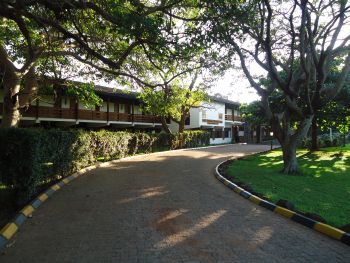 much more so than we anticipated! Mornings were chilly on the Ngorongoro crater rim at 2400m so we were pleased we had included some warm clothing in our packing. Back to Index
much more so than we anticipated! Mornings were chilly on the Ngorongoro crater rim at 2400m so we were pleased we had included some warm clothing in our packing. Back to Index
ITINERARY - 18th May to 2nd June 2013
Day 1 Arrival in Arusha - Ngare Sero Mountain Lodge
Day 2 Full day at Oldonyo Sambu/Lark Plains - Ngare Sero Mountain Lodge
Day 3 Full day in Arusha National Park - Ngare Sero Mountain Lodge
Day 4 Arusha to Tarangire NP - Tarangire Sopa Lodge
Day 5 Full day in Tarangire NP - Tarangire Sopa Lodge
Day 6 Tarangire to Lake Manyara area - Lake Manyara Wildlife Lodge
Day 7 Full day in Lake Manyara NP - Lake Manyara Wildlife Lodge
Day 8 Lake Manyara to Ngorongoro Crater rim - Ngorongoro Sopa Lodge
Day 9 Full day in Ngorongoro Crater - Ngorongoro Sopa Lodge
Day 10 Ngorongoro Crater to the Serengeti via Oldupai Gorge - Seronera Wildlife Lodge
Day 11 Serengeti National Park – Western Corridor - Seronera Wildlife Lodge
Day 12 Serengeti N P – southern to central region - Serengeti Sopa Lodge
Day 13 Serengeti N P – southern region & Moru Kopjes - Serengeti Sopa Lodge
Day 14 Serengeti N P to Kitela Lodge - Kitela Lodge
Day 15 Gibb's Farm & surrounds - Kitela Lodge
Day 16 Kitela Lodge to Arusha for departure - day room at Ngare Sero Mountain Lodge
Back to Index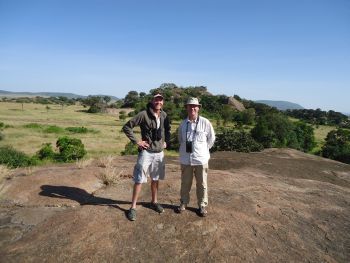
GUIDE - Wayne Jones. Although Wayne had been in Tanzania & Kenya for a little over 5 weeks, he threw himself into our trip with gusto. We enjoyed his company and he proved to be an excellent bird and wildlife guide. We would quite happily go birding with Wayne again. Back to Index
DIARY
Saturday 18th May
With our flight to Amsterdam leaving Manchester at 05.55hrs and arriving in Kilimanjaro at 19.45hrs this was a very long day. Having had a decent meal on the flight, we arrived at Ngare Sero c21.00hrs, briefly met Wayne, unpacked and went straight to bed.
Sunday 19th May
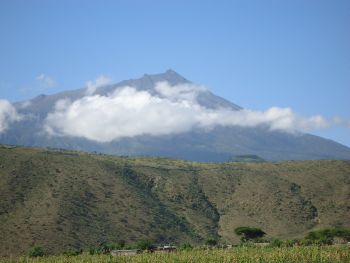 We joined Wayne for an early breakfast at 06.30hrs before heading off through Arusha and then north along the A104 for the area known as Lark Plains. The day dawned clear and bright affording splendid views of Mount Meru which dominates the Arusha skyline. As we left Ngare Sero we spotted the first of c10 Silvery-cheeked Hornbill flying overhead and giving us our first lifer, along with the first of several Augur Buzzard perched on a nearby dead tree. Leaving Arusha behind we made a few roadside stops, picking up Rufous-naped Lark, Common Fiscal, Winding Cisticola, c10 Chestnut Weaver, a few distant Fischer’s Lovebird and c30 Horus Swift. As we approached the village of Oldonyo Sambu we spotted numerous Pied Crow and had a fleeting glimpse of a Bearded Vulture (Lammergeier). The village hosts a regular meat market, which had been held the day before, and hence the attraction for the birds. We slowly made our way off-road and through the village to the gorge and hillside beyond. As we searched the area for the Lammergeier, we came across the only pair of White-fronted Bee-eater of the trip, White-bellied Canary, African Grey Flycatcher and a single White-necked Raven, before the Lammergeier soared majestically just above our heads, chased by Pied Crow. Although we have seen Lammergeier several times before, we have never had such close-up views of this magnificent bird and within a few hours of the start of our trip we were totally blown-away as we watched the bird for almost 30 minutes. Red-throated Tit, Kenya Sparrow and Reichenow’s Seedeater, all lifers, passed by almost un-noticed as we watched, entranced.
We joined Wayne for an early breakfast at 06.30hrs before heading off through Arusha and then north along the A104 for the area known as Lark Plains. The day dawned clear and bright affording splendid views of Mount Meru which dominates the Arusha skyline. As we left Ngare Sero we spotted the first of c10 Silvery-cheeked Hornbill flying overhead and giving us our first lifer, along with the first of several Augur Buzzard perched on a nearby dead tree. Leaving Arusha behind we made a few roadside stops, picking up Rufous-naped Lark, Common Fiscal, Winding Cisticola, c10 Chestnut Weaver, a few distant Fischer’s Lovebird and c30 Horus Swift. As we approached the village of Oldonyo Sambu we spotted numerous Pied Crow and had a fleeting glimpse of a Bearded Vulture (Lammergeier). The village hosts a regular meat market, which had been held the day before, and hence the attraction for the birds. We slowly made our way off-road and through the village to the gorge and hillside beyond. As we searched the area for the Lammergeier, we came across the only pair of White-fronted Bee-eater of the trip, White-bellied Canary, African Grey Flycatcher and a single White-necked Raven, before the Lammergeier soared majestically just above our heads, chased by Pied Crow. Although we have seen Lammergeier several times before, we have never had such close-up views of this magnificent bird and within a few hours of the start of our trip we were totally blown-away as we watched the bird for almost 30 minutes. Red-throated Tit, Kenya Sparrow and Reichenow’s Seedeater, all lifers, passed by almost un-noticed as we watched, entranced.
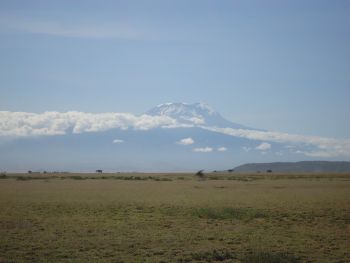 We eventually moved on to Lark Plains as temperatures soared, with spectacular views of Mount Meru to the south and Kilimanjaro, in all its splendour, to the east. New birds came fast and furious; Slate-coloured Boubou, Superb Starling (a lifer today, but so numerous, it was virtually ignored within 24 hours), Fischer’s Sparrowlark, Eastern Chanting Goshawk, the surprisingly stout-billed Short-tailed Lark and Foxy Lark were all seen, before, with the aid of two local tribesmen, we spotted our main target, Beesley’s Lark, a recently identified endemic which is only found in this one spot. We were able to get close views of a pair of larks and confirm key characteristics. A few Thomson’s Gazelle and Plains Zebra wandered around nearby as we added an initially elusive Red-fronted Warbler, Taita Fiscal and Red-winged Lark. Moving on a little further north, on a track running parallel to the A104, Wayne spotted a few Athi Short-toed Lark flitting about in the roadside grass. We watched and wandered after them for nearly 20 minutes before we had satisfactory views of a pair of them in the clear, on the ground about 10 metres away and were able to confirm their ID. A confiding pair of Chestnut-bellied Sandgrouse on the track were our only sighting of that particular Sandgrouse on the trip.
We eventually moved on to Lark Plains as temperatures soared, with spectacular views of Mount Meru to the south and Kilimanjaro, in all its splendour, to the east. New birds came fast and furious; Slate-coloured Boubou, Superb Starling (a lifer today, but so numerous, it was virtually ignored within 24 hours), Fischer’s Sparrowlark, Eastern Chanting Goshawk, the surprisingly stout-billed Short-tailed Lark and Foxy Lark were all seen, before, with the aid of two local tribesmen, we spotted our main target, Beesley’s Lark, a recently identified endemic which is only found in this one spot. We were able to get close views of a pair of larks and confirm key characteristics. A few Thomson’s Gazelle and Plains Zebra wandered around nearby as we added an initially elusive Red-fronted Warbler, Taita Fiscal and Red-winged Lark. Moving on a little further north, on a track running parallel to the A104, Wayne spotted a few Athi Short-toed Lark flitting about in the roadside grass. We watched and wandered after them for nearly 20 minutes before we had satisfactory views of a pair of them in the clear, on the ground about 10 metres away and were able to confirm their ID. A confiding pair of Chestnut-bellied Sandgrouse on the track were our only sighting of that particular Sandgrouse on the trip.
We drove along a little further to a dried-up river bed, promisingly lined with scrub and small Acacias. Wherever we have been in Africa we have found that, no matter how far you appear to be from civilization, you are never alone! We stepped out of the vehicle and before you could say "Northern Crombec and Black-faced Waxbill", we had an audience of at least 6 young children, all eager to invade our personal space and make as much noise as they possibly could. 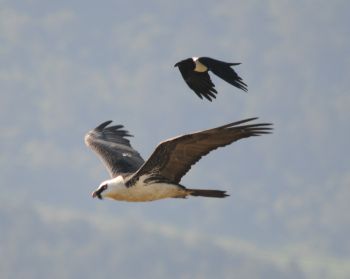 Several of them appeared to understand English as Wayne asked them to be quiet and leave us in peace so we could watch birds, but the noise level only increased, as did their persistence. We managed to pick up Banded Parisoma, Red-faced Crombec, Southern Grossbeak-Canary, Yellow-bellied Eremomela and, much to Wayne’s surprise, up to 10 more Red-fronted Warbler before we gave up and returned to the vehicle, under a shady, but very thorny Acacia.
Several of them appeared to understand English as Wayne asked them to be quiet and leave us in peace so we could watch birds, but the noise level only increased, as did their persistence. We managed to pick up Banded Parisoma, Red-faced Crombec, Southern Grossbeak-Canary, Yellow-bellied Eremomela and, much to Wayne’s surprise, up to 10 more Red-fronted Warbler before we gave up and returned to the vehicle, under a shady, but very thorny Acacia.
We retraced our steps a few kilometres back towards Arusha in an attempt to find some more off-road shade where we could have our picnic lunch. This proved to be another very productive stop as we added Grey-capped Social Weaver, Nubian and Cardinal Woodpecker, Violet-backed Sunbird, the diminutive and aptly named Tiny Cisticola, Golden-breasted Bunting and Pygmy Falcon. Moving a little further into the scrub we picked up a Mouse-coloured Penduline Tit, c4 Rufous Chatterer and an impressive Straw-tailed Whydah along with the more common Pin-tailed Whydah. By now the temperature was approaching 30°C so we decided to head back to the Lodge to cool down and rest for a while, before venturing out again around the grounds at 16.30hrs. We were rewarded with Tambourine Dove, African Paradise Flycatcher, Crowned Hornbill, Squacco Heron, Giant Kingfisher, White-eared Barbet, African Black Duck, Mountain Wagtail, Thick-billed and Taveta Weaver and a pair of Amethyst Sunbird. Sykes’ Monkey moved around in the treetops as we walked alongside the lake and weir towards the small fish farm. A very satisfactory 94 species for our first day. Back to Itinerary
Monday 20th May
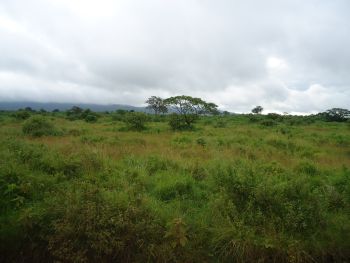 After another early breakfast we set off on a cloudy morning to spend most of the day in the nearby Arusha National Park which covers an area of 552 square kilometres (212 square miles). We stopped at the Ngongongare Gate before entering the park and as Geitan sorted out the paperwork we saw our first Baglafecht (Reichenow’s) Weaver with c6 birds around their nests. Cattle Egret and African Sacred Ibis drifted overhead as they left their overnight roosts and both Singing Cisticola and Fan-tailed Grassbird were good finds, singing from the tops of nearby bushes. As we set off into the ground-water forest with numerous Cordia africana trees and their distinctive yellow flowers, we saw a vibrant male African Stonechat, quickly followed by 3 Spot-flanked Barbet and an African Goshawk flying overhead. Moving on through the forest we came across Tropical Boubou, Trilling Cisticola, a pair of Red-backed Mannikin and Hartlaub’s Turaco before spotting a superb Black-headed Oriole. As we climbed up through the montane forest towards the Ngurdoto Crater we saw our first 3 Guereza (Black & White Colobus Monkey) in the branches overhead: I must admit I am not a big fan of monkeys and baboons, but these animals are quite extraordinary. Before reaching the crater rim we ran into a small flock of c8 Montane White-eye.
After another early breakfast we set off on a cloudy morning to spend most of the day in the nearby Arusha National Park which covers an area of 552 square kilometres (212 square miles). We stopped at the Ngongongare Gate before entering the park and as Geitan sorted out the paperwork we saw our first Baglafecht (Reichenow’s) Weaver with c6 birds around their nests. Cattle Egret and African Sacred Ibis drifted overhead as they left their overnight roosts and both Singing Cisticola and Fan-tailed Grassbird were good finds, singing from the tops of nearby bushes. As we set off into the ground-water forest with numerous Cordia africana trees and their distinctive yellow flowers, we saw a vibrant male African Stonechat, quickly followed by 3 Spot-flanked Barbet and an African Goshawk flying overhead. Moving on through the forest we came across Tropical Boubou, Trilling Cisticola, a pair of Red-backed Mannikin and Hartlaub’s Turaco before spotting a superb Black-headed Oriole. As we climbed up through the montane forest towards the Ngurdoto Crater we saw our first 3 Guereza (Black & White Colobus Monkey) in the branches overhead: I must admit I am not a big fan of monkeys and baboons, but these animals are quite extraordinary. Before reaching the crater rim we ran into a small flock of c8 Montane White-eye.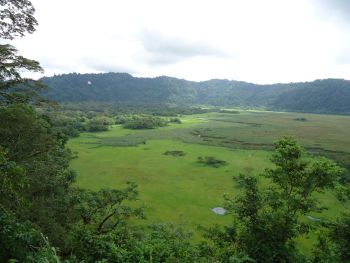 We disembarked at Mikindu Observation Point, looking out over the crater – quite a spectacle really, but a little disappointing when subsequently compared to the Ngorongoro. On the crater floor a herd of c50 African Buffalo browsed the swampy grassland alongside Spur-winged Goose and 5 Grey Crowned Crane, whilst a lone Long-crested Eagle perched on a dead tree stump.
We disembarked at Mikindu Observation Point, looking out over the crater – quite a spectacle really, but a little disappointing when subsequently compared to the Ngorongoro. On the crater floor a herd of c50 African Buffalo browsed the swampy grassland alongside Spur-winged Goose and 5 Grey Crowned Crane, whilst a lone Long-crested Eagle perched on a dead tree stump.
We moved on around the crater rim towards Lake Longil and Lokie Swamp: although it was quiet for long stretches, we did come across several mixed bird flocks and by now the clouds had given way to brilliant sunshine. Forest birding can be quite infuriating at times as birds flit quickly in and out of sight or eventually land some distance away, usually with the sun directly behind them.....we’ve all been there! We did however manage to pick out a lone Black Cuckooshrike, a pair of Kenrick’s Starling, White-eyed Slaty Flycatcher and a very elusive Green-backed Honeybird. Lake Longil was fairly quiet with a single White-breasted Cormorant, a pair of White-backed Duck and Spectacled Weaver being the only birds of note. 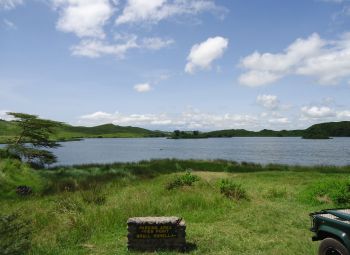 We moved on to the elevated picnic area at Small Momella Lake for a spot of lunch alongside Red-collared Widowbird, a pair of Brown Snake Eagle and, making quite a noise in the water below us, our first 3 Hippopotamus. Banded Groundling, a species of dragonfly in the family Libellulidae, littered the path like confetti and as we ate our lunch enjoying the view over the lake, a flock of c20 Chestnut Weaver circled overhead before landing, quite conveniently, for a few seconds in a nearby tree.
We moved on to the elevated picnic area at Small Momella Lake for a spot of lunch alongside Red-collared Widowbird, a pair of Brown Snake Eagle and, making quite a noise in the water below us, our first 3 Hippopotamus. Banded Groundling, a species of dragonfly in the family Libellulidae, littered the path like confetti and as we ate our lunch enjoying the view over the lake, a flock of c20 Chestnut Weaver circled overhead before landing, quite conveniently, for a few seconds in a nearby tree.
After lunch we moved on to Large Momella Lake where there must have been c2000 Lesser Flamingo with c20 Greater Flamingo dotted amongst the throng. As we drove around the lake Wayne thought he heard an African Fish Eagle overhead, but after a good look around we discovered it was a White-browed Robin Chat, which went on to give an excellent imitation of Greater Honeyguide as well. Driving around the lake hundreds of Black Saw-wing had landed in the roadside treetops, whilst on the road (track) we saw our first African Hoopoe, Long-billed Pipit and 3 Streaky Seedeater. A “showy” Moustached Grass Warbler performed on the tops of roadside bushes for us as we made our way out of the park and we eventually saw a “real” African Fish Eagle.
Back at the lodge for a welcome rest, we still had time to pick up Eastern Olive Sunbird and 4 Retz’s Helmetshrike before dinner to take our day’s list to 84. Other wildlife seen today included:- Waterbuck, Maasai Giraffe, Plains Zebra, Bushbuck, Olive Baboon, Suni, Harvey’s Duiker, Warthog, Banded Mongoose, Sykes’ Monkey and Striped Skink. Back to Itinerary
Tuesday 21st May
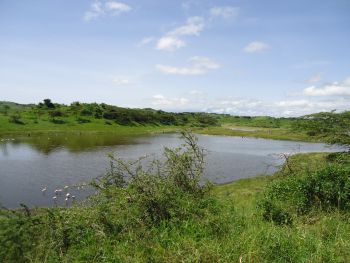 We had a lie-in today with breakfast at 07.00hrs before we left Ngare Sero in light rain for Tarangire National Park approximately 118 kilometres (75 miles) south west of Arusha. By the time we made our first stop alongside Arusha Airport on the A104 the rain had stopped and we picked up our first two lifers of the day; Pangani Longclaw and Long-tailed Fiscal. The A104 should have provided a good road surface almost all the way to our destination; however, a new section of road is under construction and there is a 20 kilometre detour, running parallel to the road and crossing regularly from side to side. Besides being an extremely uneven and dusty track, the detour, believe it or not, has regular speed bumps every 100 metres or so. As we left Arusha behind the land became much more open and arid and we regularly came across Maasai herdsmen and their cattle and goats. We saw the first of many Lilac-breasted Roller and, nearing the end of the detour, we passed a small nesting colony of Southern Red Bishop in a roadside patch of greenery. As the landscape changed, so did the birds, and we encountered our first Black-winged Kite and Common Ostrich, along with a Martial Eagle drifting lazily overhead.
We had a lie-in today with breakfast at 07.00hrs before we left Ngare Sero in light rain for Tarangire National Park approximately 118 kilometres (75 miles) south west of Arusha. By the time we made our first stop alongside Arusha Airport on the A104 the rain had stopped and we picked up our first two lifers of the day; Pangani Longclaw and Long-tailed Fiscal. The A104 should have provided a good road surface almost all the way to our destination; however, a new section of road is under construction and there is a 20 kilometre detour, running parallel to the road and crossing regularly from side to side. Besides being an extremely uneven and dusty track, the detour, believe it or not, has regular speed bumps every 100 metres or so. As we left Arusha behind the land became much more open and arid and we regularly came across Maasai herdsmen and their cattle and goats. We saw the first of many Lilac-breasted Roller and, nearing the end of the detour, we passed a small nesting colony of Southern Red Bishop in a roadside patch of greenery. As the landscape changed, so did the birds, and we encountered our first Black-winged Kite and Common Ostrich, along with a Martial Eagle drifting lazily overhead.
As we reached Tarangire National Park the landscape became greener again and although most of the animals were in the south of the park after the rains (only migrating north as grass supplies run out), we still encountered lots of new bird species, especially around the park entrance and headquarters buildings. 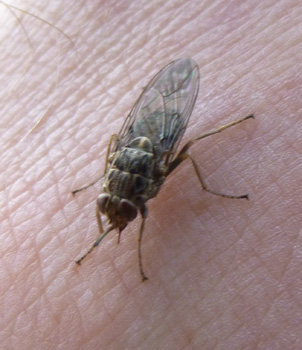 At one stage on arrival, new species appeared almost too quickly to take in: White-bellied Go-away-bird, Northern Red-billed Hornbill, Northern White-crowned Shrike, Spotted Palm Thrush, Ashy Starling, Lesser Masked Weaver, Speckle-fronted Weaver, African Grey Flycatcher, Yellow-collared Lovebird, Woodland Kingfisher, Fork-tailed Drongo, Tawny Eagle, Blue-capped Cordon-bleu, Red-necked Spurfowl, Slate-coloured Boubou, Emerald-spotted Wood Dove and Beautiful Sunbird all went into the book in an hectic 30 minutes around the park entrance. We eventually sat down to enjoy our picnic lunch, shooing away the occasional persistent Vervet Monkey and admiring an African Grey Woodpecker on one of the structures in a nearby children’s playground. We also had our first encounter with Tsetse flies here – what a joy! Maybe we had just been blind, but trip reports and the travel blurb we had read from Rockjumper and several other travel companies didn’t mention Tsetse flies as being a problem. Beware! In Tarangire, to a lesser extent, and certain parts of the Serengeti National Parks they are a complete pain, not just when you stop to admire a bird, but also as you are driving along. Long-sleeved shirts and trousers (even tucked into socks) are no defence: the flies just bite you through your clothing and insect repellant is also useless. Tsetse flies appear almost indestructible and recover from any amount of thumping, squashing underfoot and bashing with any object available. Wayne had the best solution: he bashed them, caught them and then removed at least one wing – after this trip, if ever I see Tsetse flies flying around in endless demented circles I will know Wayne has been there.
At one stage on arrival, new species appeared almost too quickly to take in: White-bellied Go-away-bird, Northern Red-billed Hornbill, Northern White-crowned Shrike, Spotted Palm Thrush, Ashy Starling, Lesser Masked Weaver, Speckle-fronted Weaver, African Grey Flycatcher, Yellow-collared Lovebird, Woodland Kingfisher, Fork-tailed Drongo, Tawny Eagle, Blue-capped Cordon-bleu, Red-necked Spurfowl, Slate-coloured Boubou, Emerald-spotted Wood Dove and Beautiful Sunbird all went into the book in an hectic 30 minutes around the park entrance. We eventually sat down to enjoy our picnic lunch, shooing away the occasional persistent Vervet Monkey and admiring an African Grey Woodpecker on one of the structures in a nearby children’s playground. We also had our first encounter with Tsetse flies here – what a joy! Maybe we had just been blind, but trip reports and the travel blurb we had read from Rockjumper and several other travel companies didn’t mention Tsetse flies as being a problem. Beware! In Tarangire, to a lesser extent, and certain parts of the Serengeti National Parks they are a complete pain, not just when you stop to admire a bird, but also as you are driving along. Long-sleeved shirts and trousers (even tucked into socks) are no defence: the flies just bite you through your clothing and insect repellant is also useless. Tsetse flies appear almost indestructible and recover from any amount of thumping, squashing underfoot and bashing with any object available. Wayne had the best solution: he bashed them, caught them and then removed at least one wing – after this trip, if ever I see Tsetse flies flying around in endless demented circles I will know Wayne has been there.
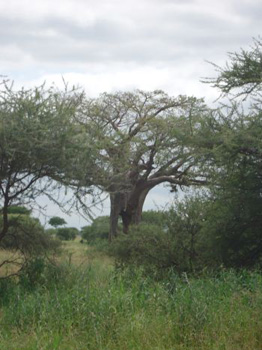 Tarangire National Park gets its name from the Tarangire River which crosses through the park and is the only source of water for wild animals during the dry season. The park lies 70 kilometres south east of Lake Manyara and covers an area of approx 2,850 square kilometres (1,096 square miles). The hilly landscape is dotted with termite mounds, vast numbers of Baobab trees, dense bush, Acacia savanna and high grasses: it supports one of the largest concentration of Elephants in Africa, evidence of which can be seen immediately as virtually every large Baobab tree is stripped of its bark as far as an elephant can reach. The bark provides important moisture during the dry season as Baobab trees are succulent plants: their massive swollen trunks consist of soft spongy wood saturated with water and Elephants tear off the bark, rip limbs and push over smaller Baobabs to get to the water the tree holds.
Tarangire National Park gets its name from the Tarangire River which crosses through the park and is the only source of water for wild animals during the dry season. The park lies 70 kilometres south east of Lake Manyara and covers an area of approx 2,850 square kilometres (1,096 square miles). The hilly landscape is dotted with termite mounds, vast numbers of Baobab trees, dense bush, Acacia savanna and high grasses: it supports one of the largest concentration of Elephants in Africa, evidence of which can be seen immediately as virtually every large Baobab tree is stripped of its bark as far as an elephant can reach. The bark provides important moisture during the dry season as Baobab trees are succulent plants: their massive swollen trunks consist of soft spongy wood saturated with water and Elephants tear off the bark, rip limbs and push over smaller Baobabs to get to the water the tree holds.
Leaving the Park Headquarters behind and heading towards our accommodation for the night, new birds continued to appear: Von Der Decken’s Hornbill, Diederik Cuckoo, Banded Parisoma and Silverbird were followed by a majestic Secretarybird sat on a nest in the top of a small Acacia. Driving through the plains we added a pair of Abyssinian Scimitarbill, Rattling Cisticola, Rufous-tailed Weaver, c12 White-backed Vulture, Rüppell’s Vulture, African Grey Hornbill, Striped Kingfisher, Bearded Woodpecker, an amorous pair of Namaqua Dove, Northern Pied Babbler and Vitelline Weaver. As we drove towards Tarangire Hill we encountered numerous Black-faced Sandgrouse, Crested Francolin, Yellow-necked Francolin and Coqui Francolin on, or at the side of the road. Birds continually run along the road in front of the vehicle, take off at the last minute and land literally 10 metres away, to begin the process over and over again. Crossing a virtually dried up river bed I spotted a lone Water Thick-knee up against the bank; we swiftly reversed for a better view. 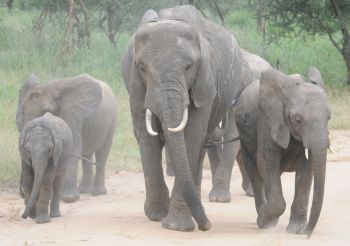 Nearing the Lodge we saw c40 Yellow-faced Lovebird in a roadside tree; as we approached they flew off to another tree a short distance away to join another 20 birds. Wayne said he had never seen such a large flock before. Two Mottled Spinetail flew over as we reached the Lodge to provide a fine welcome, but the day’s birding was not over yet; we had just dropped our cases in the room when Wayne knocked on the door to show us a Scarlet-chested Sunbird and a Greater Blue-eared Starling in the sparse trees just outside. After unpacking and a brief rest watching life go by from our balcony we adjourned to the Lodge for dinner, before which we watched c3 Freckled Nightjar and c10 Slender-tailed Nightjar by torchlight as they flew around the building catching insects and landed from time to time on the roof.
Nearing the Lodge we saw c40 Yellow-faced Lovebird in a roadside tree; as we approached they flew off to another tree a short distance away to join another 20 birds. Wayne said he had never seen such a large flock before. Two Mottled Spinetail flew over as we reached the Lodge to provide a fine welcome, but the day’s birding was not over yet; we had just dropped our cases in the room when Wayne knocked on the door to show us a Scarlet-chested Sunbird and a Greater Blue-eared Starling in the sparse trees just outside. After unpacking and a brief rest watching life go by from our balcony we adjourned to the Lodge for dinner, before which we watched c3 Freckled Nightjar and c10 Slender-tailed Nightjar by torchlight as they flew around the building catching insects and landed from time to time on the roof.
We saw 103 bird species today as well Ochre Bush Squirrel, Banded Mongoose, Yellow-spotted (Bush) Hyrax, Elephant (lots), Warthog, Maasai Giraffe, Waterbuck, Impala, Kirk’s Dikdik, Rock Monitor and Striped Skink. Back to Itinerary
Wednesday 22nd May
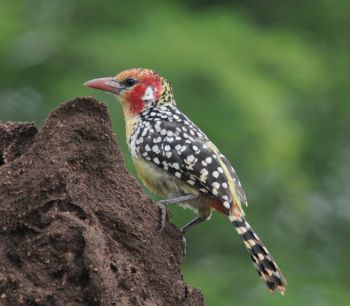 Today we headed slowly south at 07.15hrs as far as the Tarangire River road bridge, for a day in the National Park. Just outside the Lodge grounds we had much better views than yesterday of c10 Mottled Spinetail as they circled over the Baobab trees and a few Red-necked Spurfowl scuttled about in roadside ditches. We saw several Flappet Lark during the morning along with a couple of Meyer’s Parrot and numerous White-headed Buffalo Weaver. A pair of Greater Blue-eared Starling, which are not that common in northern Tanzania, perched by the roadside, along with 3 Pygmy Falcon. As we drove along we saw our first Wattled Starling and a pair of D’Arnaud’s Barbet; we were now tracking the Tarangire River and a pair of Yellow-billed Stork caught our attention, together with a Malagasy Pond Heron which eventually flew off over the river. A Red-chested Cuckoo called and then flew over the road to perch in a nearby tree as a pair of Red-bellied Parrot flew overhead. Next we were treated to close up views of a Red-and-yellow Barbet as it set about attacking a roadside termite mound. In another mound nearby, a family of Dwarf Mongoose played hide-and-seek as they watched us, watching them, and posed for a few photos, as did a Marico Sunbird. We watched an Unstriped Ground Squirrel as a herd of c50 Elephant browsed and meandered along the opposite river bank. Continuing on our southerly trail we saw a small raptor silhouetted against the clear blue sky in a roadside tree; approaching with caution we found a Red-necked Falcon consuming the remains of its prey. We watched for a while, edging closer and closer, trying to get a good photo and not disturb the bird, which eventually finished it’s meal, preened for a while, contemplated the beautiful day, defecated and eventually flew off in search of new adventure.
Today we headed slowly south at 07.15hrs as far as the Tarangire River road bridge, for a day in the National Park. Just outside the Lodge grounds we had much better views than yesterday of c10 Mottled Spinetail as they circled over the Baobab trees and a few Red-necked Spurfowl scuttled about in roadside ditches. We saw several Flappet Lark during the morning along with a couple of Meyer’s Parrot and numerous White-headed Buffalo Weaver. A pair of Greater Blue-eared Starling, which are not that common in northern Tanzania, perched by the roadside, along with 3 Pygmy Falcon. As we drove along we saw our first Wattled Starling and a pair of D’Arnaud’s Barbet; we were now tracking the Tarangire River and a pair of Yellow-billed Stork caught our attention, together with a Malagasy Pond Heron which eventually flew off over the river. A Red-chested Cuckoo called and then flew over the road to perch in a nearby tree as a pair of Red-bellied Parrot flew overhead. Next we were treated to close up views of a Red-and-yellow Barbet as it set about attacking a roadside termite mound. In another mound nearby, a family of Dwarf Mongoose played hide-and-seek as they watched us, watching them, and posed for a few photos, as did a Marico Sunbird. We watched an Unstriped Ground Squirrel as a herd of c50 Elephant browsed and meandered along the opposite river bank. Continuing on our southerly trail we saw a small raptor silhouetted against the clear blue sky in a roadside tree; approaching with caution we found a Red-necked Falcon consuming the remains of its prey. We watched for a while, edging closer and closer, trying to get a good photo and not disturb the bird, which eventually finished it’s meal, preened for a while, contemplated the beautiful day, defecated and eventually flew off in search of new adventure.
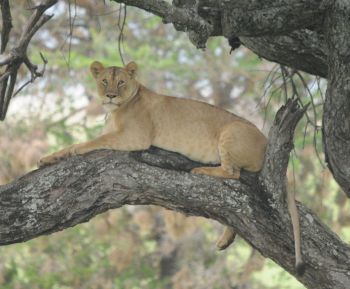 When we reached the road bridge we stopped to view the river: we had brief views of a Goliath Heron before it disappeared behind a lone tree on a grassy island as the river meandered away to the right. Both Malachite and Pied Kingfisher were active nearby and several Lesser Striped Swallow landed on a bare branch at the side of the bridge, posing for an eager photographer. Three-banded Plover and 3 Water Thick-knee worked the shallows on the sandy edge of the water whilst 2 Whiskered Tern quartered up and down the river and a lone Saddle-billed Stork joined the 50 or so Yellow-billed Stork on the sandbanks and in the surrounding trees. We turned around and retraced our steps back over the bridge and spotted a recently deceased Flat-snouted Wolf Snake on the track leading to the ford across the river. A party of 5 Harlequin Quail by the roadside were a good find as the most common sighting of this species had previously been the rear end of a bird which had been disturbed by our approach and, after a short flight, was disappearing into the long grass. A juvenile African Hawk Eagle drifted overhead as Croaking Cisticola lived up to its name from the top of a roadside bush. By now it was lunch time and we were approaching the picnic spot at Silale Swamp: the presence of several vehicles below us on the edge of the swamp alerted us to a Lioness in one of the trees and, not wishing to miss the opportunity, we went for a closer look before our picnic lunch. Just as well really; by the time we had finished the tree was bare and the vehicles had disappeared.
When we reached the road bridge we stopped to view the river: we had brief views of a Goliath Heron before it disappeared behind a lone tree on a grassy island as the river meandered away to the right. Both Malachite and Pied Kingfisher were active nearby and several Lesser Striped Swallow landed on a bare branch at the side of the bridge, posing for an eager photographer. Three-banded Plover and 3 Water Thick-knee worked the shallows on the sandy edge of the water whilst 2 Whiskered Tern quartered up and down the river and a lone Saddle-billed Stork joined the 50 or so Yellow-billed Stork on the sandbanks and in the surrounding trees. We turned around and retraced our steps back over the bridge and spotted a recently deceased Flat-snouted Wolf Snake on the track leading to the ford across the river. A party of 5 Harlequin Quail by the roadside were a good find as the most common sighting of this species had previously been the rear end of a bird which had been disturbed by our approach and, after a short flight, was disappearing into the long grass. A juvenile African Hawk Eagle drifted overhead as Croaking Cisticola lived up to its name from the top of a roadside bush. By now it was lunch time and we were approaching the picnic spot at Silale Swamp: the presence of several vehicles below us on the edge of the swamp alerted us to a Lioness in one of the trees and, not wishing to miss the opportunity, we went for a closer look before our picnic lunch. Just as well really; by the time we had finished the tree was bare and the vehicles had disappeared.
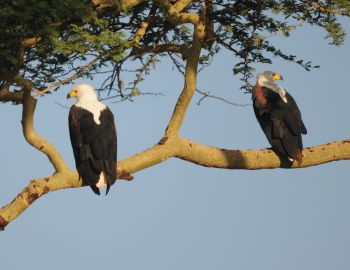 We drove down to the edge of the swamp as we had noticed several birds on the open water whilst eating lunch. Wayne was initially delighted to spot 3 Lesser Moorhen and then subsequently quite amazed as during the next 30 minutes we saw more than a dozen amongst the Hottentot Teal, Fulvous Whistling Duck, African Jacana, White-backed Duck, Red-billed Teal, Little Grebe, Southern Pochard, White-faced Whistling Duck, plus a single African Swamphen and 3 Allen’s Gallinule. An African Marsh Harrier floated leisurely across the swamp whilst 12 Glossy Ibis joined both Great and Intermediate Egret, alongside Sacred Ibis and African Openbill to make quite a haul of water birds. Around the fringes of the swamp we spotted c8 Crimson-rumped Waxbill, a pair of White-winged Widowbird and c30 Reed Cormorant roosting in the trees, along with a Gabar Goshawk and 2 Southern Ground Horbill. Meanwhile, a lone Elephant plied its way around the swamp and as we headed back to the Lodge we spotted a Steenbok and 4 Maasai Giraffe, with the only bird of note being a single Black-bellied Bustard. Before dinner we again watched both Freckled and Slender-tailed Nightjar hawking around the Lodge buildings, having seen 112 species during the day. Back to Itinerary
We drove down to the edge of the swamp as we had noticed several birds on the open water whilst eating lunch. Wayne was initially delighted to spot 3 Lesser Moorhen and then subsequently quite amazed as during the next 30 minutes we saw more than a dozen amongst the Hottentot Teal, Fulvous Whistling Duck, African Jacana, White-backed Duck, Red-billed Teal, Little Grebe, Southern Pochard, White-faced Whistling Duck, plus a single African Swamphen and 3 Allen’s Gallinule. An African Marsh Harrier floated leisurely across the swamp whilst 12 Glossy Ibis joined both Great and Intermediate Egret, alongside Sacred Ibis and African Openbill to make quite a haul of water birds. Around the fringes of the swamp we spotted c8 Crimson-rumped Waxbill, a pair of White-winged Widowbird and c30 Reed Cormorant roosting in the trees, along with a Gabar Goshawk and 2 Southern Ground Horbill. Meanwhile, a lone Elephant plied its way around the swamp and as we headed back to the Lodge we spotted a Steenbok and 4 Maasai Giraffe, with the only bird of note being a single Black-bellied Bustard. Before dinner we again watched both Freckled and Slender-tailed Nightjar hawking around the Lodge buildings, having seen 112 species during the day. Back to Itinerary
Thursday 23rd May
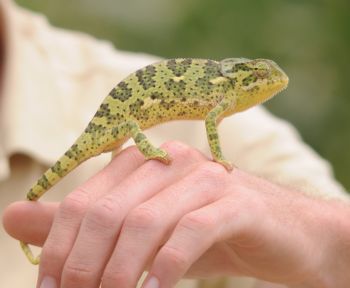 Today was our last in Tarangire National Park so we spent the morning on a leisurely drive north towards the Park Headquarters, hoping to pick up several species which had previously eluded us. Near the Lodge we came across a pair of Hilderbrandt’s Francolin and 3 Pangani Longclaw (the only other one we had seen was at Arusha airport), plus numerous species we had already recorded, including a noteworthy flock of c160 Wattled Starling. A pair of Three-banded Courser, almost hidden in the roadside grass, was a good find, as was the occasional male Cardinal Quelea amongst the thousands of its Red-billed cousins. We had much better views of 6 White-faced Whistling Duck on a roadside pond, just after which we were completely taken aback by a Dwarf Bittern as it flew around and landed in the top of a nearby tree, before flying off into the distance. On our way down to the nearby Tarangire River we came across a Jacobin Cuckoo and our first Bohor Reedbuck. Amongst the usual suspects we spotted our first Greenshank here, along with Golden-backed and Lesser Masked Weaver busy building their nests in the reeds, and a pair of nesting Rufous-bellied Heron. A Nile Monitor was resting by the riverbank whilst a pair of Black Crake busied themselves around the water’s edge – quite a productive little spot. Moving on we found two pairs of Grey Kestrel in roadside trees and a little further down the river, 7 Great White Pelican, another 3 Bohor Reedbuck and a family of 4 Southern Ground Hornbill – not new, but one of our African favourites.
Today was our last in Tarangire National Park so we spent the morning on a leisurely drive north towards the Park Headquarters, hoping to pick up several species which had previously eluded us. Near the Lodge we came across a pair of Hilderbrandt’s Francolin and 3 Pangani Longclaw (the only other one we had seen was at Arusha airport), plus numerous species we had already recorded, including a noteworthy flock of c160 Wattled Starling. A pair of Three-banded Courser, almost hidden in the roadside grass, was a good find, as was the occasional male Cardinal Quelea amongst the thousands of its Red-billed cousins. We had much better views of 6 White-faced Whistling Duck on a roadside pond, just after which we were completely taken aback by a Dwarf Bittern as it flew around and landed in the top of a nearby tree, before flying off into the distance. On our way down to the nearby Tarangire River we came across a Jacobin Cuckoo and our first Bohor Reedbuck. Amongst the usual suspects we spotted our first Greenshank here, along with Golden-backed and Lesser Masked Weaver busy building their nests in the reeds, and a pair of nesting Rufous-bellied Heron. A Nile Monitor was resting by the riverbank whilst a pair of Black Crake busied themselves around the water’s edge – quite a productive little spot. Moving on we found two pairs of Grey Kestrel in roadside trees and a little further down the river, 7 Great White Pelican, another 3 Bohor Reedbuck and a family of 4 Southern Ground Hornbill – not new, but one of our African favourites.
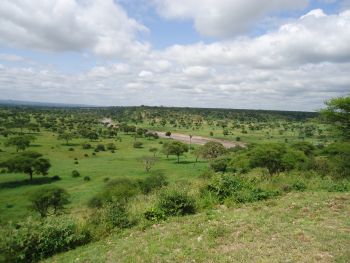 As we neared the park entrance we made a detour to the Tarangire Safari Lodge which sits on a hillside overlooking the Tarangire River and commands a superb view of the surrounding plains. No sooner had we arrived at the lodge than one of the staff was eagerly showing us a roosting African Scops Owl, nestled in a space in the eaves of the roof of one of the tented cabins. We stopped here to specifically look for Collared Palm Thrush as this was supposedly the only place on our itinerary where it was a possibility. No luck; but we did find a pair of Bare-eyed Thrush, together with several Buff-bellied Warbler and had excellent views of Red-and-yellow Barbet and Black-headed Oriole. Once again we had a picnic lunch in the grounds at the park gates and shortly after leaving, we screeched to a halt as Wayne had spotted a Flap-necked Chameleon crossing the road as we passed. Much to our surprise he shot out of the vehicle and caught the chameleon just as it was about to disappear in to the grass verge. Neither Amanda or I had held a chameleon before and Wayne carefully passed it to us, as it slowly changed colour. Such a small event, but one of the most memorable experiences of our holiday, which we will both treasure for years to come.
As we neared the park entrance we made a detour to the Tarangire Safari Lodge which sits on a hillside overlooking the Tarangire River and commands a superb view of the surrounding plains. No sooner had we arrived at the lodge than one of the staff was eagerly showing us a roosting African Scops Owl, nestled in a space in the eaves of the roof of one of the tented cabins. We stopped here to specifically look for Collared Palm Thrush as this was supposedly the only place on our itinerary where it was a possibility. No luck; but we did find a pair of Bare-eyed Thrush, together with several Buff-bellied Warbler and had excellent views of Red-and-yellow Barbet and Black-headed Oriole. Once again we had a picnic lunch in the grounds at the park gates and shortly after leaving, we screeched to a halt as Wayne had spotted a Flap-necked Chameleon crossing the road as we passed. Much to our surprise he shot out of the vehicle and caught the chameleon just as it was about to disappear in to the grass verge. Neither Amanda or I had held a chameleon before and Wayne carefully passed it to us, as it slowly changed colour. Such a small event, but one of the most memorable experiences of our holiday, which we will both treasure for years to come.
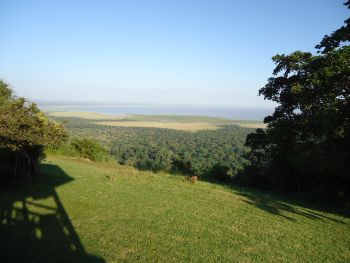 Lake Manyara is only a short drive from Tarangire National Park. The entrance gate lies about 1.5 hours (126kilometres/80 miles) west of Arusha. As the day was quite hot we decided not to visit Lake Manyara today but head straight to Lake Manyara Wildlife Lodge, which sits on the edge of the escarpment overlooking the lake and has amazing views. We knew we would have plenty of opportunity tomorrow to explore some of the park’s 330 square kilometres (127 square miles) - up to 200 square kilometres (77 square miles) is lake when water levels are high. As we left the B144 on the track leading to our lodge, we spotted our first (and only) Black Kite and flying over the lodge, a Black-breasted Snake Eagle to make a total of 99 species for the day. A huge fruiting fig tree outside our room attracted Straw-coloured Fruit Bat from dusk onwards. Back to Itinerary
Lake Manyara is only a short drive from Tarangire National Park. The entrance gate lies about 1.5 hours (126kilometres/80 miles) west of Arusha. As the day was quite hot we decided not to visit Lake Manyara today but head straight to Lake Manyara Wildlife Lodge, which sits on the edge of the escarpment overlooking the lake and has amazing views. We knew we would have plenty of opportunity tomorrow to explore some of the park’s 330 square kilometres (127 square miles) - up to 200 square kilometres (77 square miles) is lake when water levels are high. As we left the B144 on the track leading to our lodge, we spotted our first (and only) Black Kite and flying over the lodge, a Black-breasted Snake Eagle to make a total of 99 species for the day. A huge fruiting fig tree outside our room attracted Straw-coloured Fruit Bat from dusk onwards. Back to Itinerary
Friday 24th May
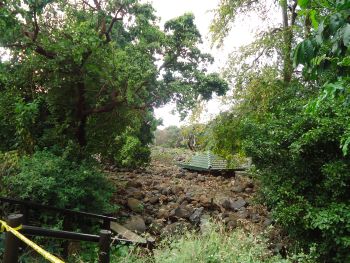 With the entrance to the park just a short distance from our lodge we only left at 07.30hrs today. On our way to the B144 through the nearby village we spotted several Yellow-billed Kite overhead, a Mocking Cliff Chat on the overhead wires and c6 Speke’s Weaver scuttling around on the ground in an area with drying maize husks. As we had passed the park entrance the previous afternoon the significance of the stretch of rough road had not really sunk in. We pulled up in the car park by the entrance to Lake Manyara National Park and through a gap in the trees saw the roof of a building surrounded by boulders. The rains, about six weeks earlier, had been quite heavy and the uneven road was only a small part of the devastation: what was a small riverbed was now strewn with large boulders, washed down the hillside by the raging torrents leaving the former park buildings buried under a sea of rubble. New tented accommodation was now being erected on the other side of the car park, away from the riverbed. Geitan advised us this kind of water damage was a regular occurrence here, begging the question why had the buildings been constructed at the side of the riverbed in the past? He also confirmed that the lake was quite “full” at present and the current shoreline was approx 1 kilometre closer than in the dry season - he said he hadn't seen water levels this high since 1988!
With the entrance to the park just a short distance from our lodge we only left at 07.30hrs today. On our way to the B144 through the nearby village we spotted several Yellow-billed Kite overhead, a Mocking Cliff Chat on the overhead wires and c6 Speke’s Weaver scuttling around on the ground in an area with drying maize husks. As we had passed the park entrance the previous afternoon the significance of the stretch of rough road had not really sunk in. We pulled up in the car park by the entrance to Lake Manyara National Park and through a gap in the trees saw the roof of a building surrounded by boulders. The rains, about six weeks earlier, had been quite heavy and the uneven road was only a small part of the devastation: what was a small riverbed was now strewn with large boulders, washed down the hillside by the raging torrents leaving the former park buildings buried under a sea of rubble. New tented accommodation was now being erected on the other side of the car park, away from the riverbed. Geitan advised us this kind of water damage was a regular occurrence here, begging the question why had the buildings been constructed at the side of the riverbed in the past? He also confirmed that the lake was quite “full” at present and the current shoreline was approx 1 kilometre closer than in the dry season - he said he hadn't seen water levels this high since 1988!
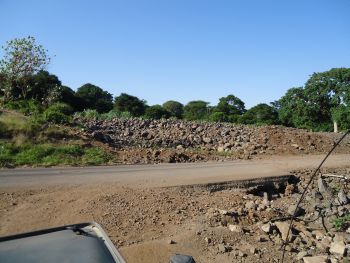 As we drove into the park a couple of Elephants descended the wooded hillside and crossed the track in front of us and both Blue Monkey and Olive Baboon moved around in the branches overhead. As the ground-water forest thinned out a little we stopped in a clearing, initially to watch Grey-backed Cameroptera and Long-tailed Paradise Whydah, but eventually a pair of African Green Pigeon flew over and landed in a nearby tree, followed by about 4 Purple-crested Turaco. An African Pygmy Kingfisher darted across the track in front of us and quickly disappeared into the undergrowth where Impala browsed. We stopped to watch a Black-backed Jackal cross the road and a Peregrine flashed by overhead, whilst 3 Chestnut Sparrow and Yellow-spotted Petronia flitted about in the roadside bushes. Imagine our surprise when not one, but two Collared Palm Thrush flew by and landed in the top of a nearby Palm tree: we thought our chance of this species had gone the previous day when we missed them at Tarangire Safari Lodge. Moving on we came across a splendid male Black Bishop and an Ashy Flycatcher before disembarking for a short while in a parking area on the edge of some swampy grassland for a welcome cup of tea.
As we drove into the park a couple of Elephants descended the wooded hillside and crossed the track in front of us and both Blue Monkey and Olive Baboon moved around in the branches overhead. As the ground-water forest thinned out a little we stopped in a clearing, initially to watch Grey-backed Cameroptera and Long-tailed Paradise Whydah, but eventually a pair of African Green Pigeon flew over and landed in a nearby tree, followed by about 4 Purple-crested Turaco. An African Pygmy Kingfisher darted across the track in front of us and quickly disappeared into the undergrowth where Impala browsed. We stopped to watch a Black-backed Jackal cross the road and a Peregrine flashed by overhead, whilst 3 Chestnut Sparrow and Yellow-spotted Petronia flitted about in the roadside bushes. Imagine our surprise when not one, but two Collared Palm Thrush flew by and landed in the top of a nearby Palm tree: we thought our chance of this species had gone the previous day when we missed them at Tarangire Safari Lodge. Moving on we came across a splendid male Black Bishop and an Ashy Flycatcher before disembarking for a short while in a parking area on the edge of some swampy grassland for a welcome cup of tea. 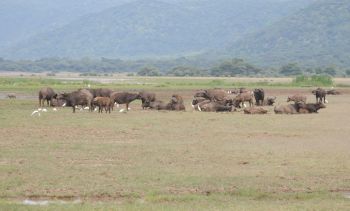 A few Hippopotamus wallowed in the shallow water nearby whilst the occasional Blue Wilderbeest (sp. White-bearded Gnu) and a herd of 100+ Buffalo roamed about in the distance. We saw our first 3 Black-winged Stilt and the only Spur-winged Lapwing of the trip, together with Long-toed Lapwing in the distance before moving on along a track running into the swamp. With small pools of water dotted around us we were right amongst the action here and the Buffalo herd; we had great close-up views of c20 Collared Pratincole, Squacco Heron, Long-tailed Fiscal, Kittlitz’s Plover, Thick-billed Weaver, African Quailfinch and Double-banded Courser, plus a distant African Spoonbill. Moving away from the water and back into the woodland we had good views of Lesser Honeyguide as both Crowned Eagle and Black-chested Snake Eagle flew overhead. A herd of c40 Plains Zebra browsed their way through a clearing where we saw c8 Blue-naped Mousebird, D’Arnaud’s and Red-and-yellow Barbet and a pair of Hildebrandt’s Starling.
A few Hippopotamus wallowed in the shallow water nearby whilst the occasional Blue Wilderbeest (sp. White-bearded Gnu) and a herd of 100+ Buffalo roamed about in the distance. We saw our first 3 Black-winged Stilt and the only Spur-winged Lapwing of the trip, together with Long-toed Lapwing in the distance before moving on along a track running into the swamp. With small pools of water dotted around us we were right amongst the action here and the Buffalo herd; we had great close-up views of c20 Collared Pratincole, Squacco Heron, Long-tailed Fiscal, Kittlitz’s Plover, Thick-billed Weaver, African Quailfinch and Double-banded Courser, plus a distant African Spoonbill. Moving away from the water and back into the woodland we had good views of Lesser Honeyguide as both Crowned Eagle and Black-chested Snake Eagle flew overhead. A herd of c40 Plains Zebra browsed their way through a clearing where we saw c8 Blue-naped Mousebird, D’Arnaud’s and Red-and-yellow Barbet and a pair of Hildebrandt’s Starling. 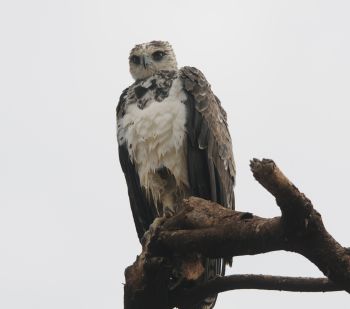 Shortly afterwards we were able to get much close views of one of the barbets and were able to confirm it was in fact an Usambiro Barbet, a sub-species of D’Arnaud’s, at the edge of its range here and more commonly encountered in the Serengeti.
Shortly afterwards we were able to get much close views of one of the barbets and were able to confirm it was in fact an Usambiro Barbet, a sub-species of D’Arnaud’s, at the edge of its range here and more commonly encountered in the Serengeti.
We stopped for lunch at a convenient picnic site before moving closer to the shore of the lake again where we had good views of an Orange-breasted Bushshrike and a pair of Eastern Violet-backed Sunbird. We moved back into the woodland and drove to an area where Lion had been spotted earlier: it appeared we were out of luck so we did a several-point-turn on the narrow track and retraced our steps. Almost immediately we saw a male and 3 females right at the side of the road, sunning themselves; we had just driven by this spot and there was definitely nothing there just a few minutes earlier. Two females soon disappeared into the roadside grass but the male and one female remained and allowed a few photos, before getting a little agitated at the noise of the camera shutter. 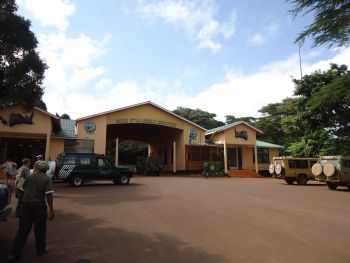 Just around the corner from here several more lions lounged in a tree and a little further on a Kirk’s Dikdik browsed at the side of the road, seemingly unaware of the nearby predators. We were now on our way out of the park and saw nothing further of note apart from several Tree Agama back at the lodge and an African Harrier Hawk which flew by as we relaxed on our balcony. Another productive day with 103 bird species and our overall lifer total approaching 100, whilst our trip list had passed 300. Back to Itinerary
Just around the corner from here several more lions lounged in a tree and a little further on a Kirk’s Dikdik browsed at the side of the road, seemingly unaware of the nearby predators. We were now on our way out of the park and saw nothing further of note apart from several Tree Agama back at the lodge and an African Harrier Hawk which flew by as we relaxed on our balcony. Another productive day with 103 bird species and our overall lifer total approaching 100, whilst our trip list had passed 300. Back to Itinerary
Saturday 25th May
With only a relatively short journey to the Ngorongoro Conservation Area we returned to Lake Manyara National Park at 07.45 to try and pick up any species we missed yesterday. Taking several different tracks and exploring new areas, the only new species we encountered was White-headed Barbet, but we did have stunning views of a juvenile Martial Eagle perched just above our heads on a roadside tree. When we passed the tree again, well over an hour later on our way out of the park, the bird was still perched serenely in the same spot. We also had much better views than previously of a family of c6 Rufous Chatterer as the young birds begged for food from their parents. We returned to the lodge for lunch where we eventually caught up with White-bellied Tit, which Wayne had heard (and seen whilst by himself) on both previous days here.
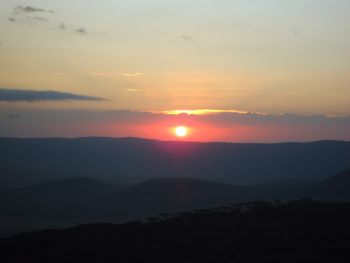 After lunch it didn’t take us long to reach the entrance to the Ngorongoro Conservation Area at the Lodoare Gate. The B144 continues beyond the gate through the Serengeti National Park north to the Maasai Mara National Reserve across the border in Kenya. The surfaced road however ends at the gate, which is approx is 160 kilometres from Arusha. On our way to the crater rim we had distant views of our first Cinnamon-chested Bee-eater and also saw a pair of White-necked Raven and a Crowned Eagle. We arrived at the Ngorongoro Sopa Lodge by mid afternoon and retired to our room to freshen up and relax. Walking back to the main lodge buildings as the sun dropped towards the crater rim we spotted an Eastern Double-collared Sunbird and White-eyed Slaty Flycatcher and, with the sun right behind it and no colour visible whatsoever, our first Golden-winged Sunbird. We did see about 20 of these splendid birds the following day in much better light! Enjoying a beer, we watched the beautiful sunset over the crater rim and managed to pick out 2 Montane Nightjar by torchlight in the gathering gloom, to take our daily total to 81 bird species. Back to Itinerary
After lunch it didn’t take us long to reach the entrance to the Ngorongoro Conservation Area at the Lodoare Gate. The B144 continues beyond the gate through the Serengeti National Park north to the Maasai Mara National Reserve across the border in Kenya. The surfaced road however ends at the gate, which is approx is 160 kilometres from Arusha. On our way to the crater rim we had distant views of our first Cinnamon-chested Bee-eater and also saw a pair of White-necked Raven and a Crowned Eagle. We arrived at the Ngorongoro Sopa Lodge by mid afternoon and retired to our room to freshen up and relax. Walking back to the main lodge buildings as the sun dropped towards the crater rim we spotted an Eastern Double-collared Sunbird and White-eyed Slaty Flycatcher and, with the sun right behind it and no colour visible whatsoever, our first Golden-winged Sunbird. We did see about 20 of these splendid birds the following day in much better light! Enjoying a beer, we watched the beautiful sunset over the crater rim and managed to pick out 2 Montane Nightjar by torchlight in the gathering gloom, to take our daily total to 81 bird species. Back to Itinerary
Sunday 26th May
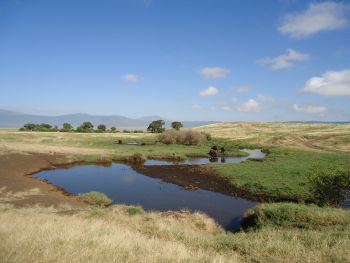 On a gloomy, cloudy morning we set off at 07.00hrs to go down into the Ngorongoro crater. We stopped at the entrance gate for about 30 minutes to see what we could find and were rewarded with Brown Parisoma, Southern Citril and Cape Robin Chat. Descending towards the crater floor we spotted Dusky Turtle Dove and a little further on, as the trees disappeared to be replaced by low-lying scrub, both Bronzy and Malachite Sunbird. Almost at the crater floor as we moved in to the grasslands we encountered our first mixed herd of Plains Zebra and Buffalo, spread across the road and the hillside, together with attendant Oxpeckers. A splendid pair of Rosy-throated Longclaw, especially the male, proved very photogenic and as the land flattened out we came across Plain-backed Pipit, several Winding Cisticola and numerous Northern Anteater Chat. Both Grant’s and Thomson’s Gazelle, Warthog and Blue Wilderbeest were everywhere and not to be outdone, we had more close-up views of African Quailfinch, Red-capped Lark, Pectoral Patch Cisticola, Capped Wheatear and Fan-tailed Widowbird. We stopped to admire a Spotted Hyena plus a youngster with several more almost hidden in a nearby ditch and an imposing bull Elephant strode majestically across the road in front of us. Both Black-backed and Golden Jackal roamed around the grassland with c10 Kori Bustard.
On a gloomy, cloudy morning we set off at 07.00hrs to go down into the Ngorongoro crater. We stopped at the entrance gate for about 30 minutes to see what we could find and were rewarded with Brown Parisoma, Southern Citril and Cape Robin Chat. Descending towards the crater floor we spotted Dusky Turtle Dove and a little further on, as the trees disappeared to be replaced by low-lying scrub, both Bronzy and Malachite Sunbird. Almost at the crater floor as we moved in to the grasslands we encountered our first mixed herd of Plains Zebra and Buffalo, spread across the road and the hillside, together with attendant Oxpeckers. A splendid pair of Rosy-throated Longclaw, especially the male, proved very photogenic and as the land flattened out we came across Plain-backed Pipit, several Winding Cisticola and numerous Northern Anteater Chat. Both Grant’s and Thomson’s Gazelle, Warthog and Blue Wilderbeest were everywhere and not to be outdone, we had more close-up views of African Quailfinch, Red-capped Lark, Pectoral Patch Cisticola, Capped Wheatear and Fan-tailed Widowbird. We stopped to admire a Spotted Hyena plus a youngster with several more almost hidden in a nearby ditch and an imposing bull Elephant strode majestically across the road in front of us. Both Black-backed and Golden Jackal roamed around the grassland with c10 Kori Bustard.
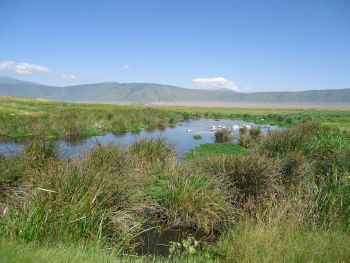 There was plenty of bird activity on and around Lake Magadi and the Mandusi Swamp, with many of the usual water birds and waders joined by c4 African Spoonbill, Whiskered Tern, Grey-headed Gull, at least 2 Gull-billed Tern, Chestnut-banded Plover and Red-knobbed Coot. There were c20 Hippopotamus wallowing in one small reed-fringed pool, some of them amusing us by turning upside down and lying almost totally submerged for quite long periods. Whilst watching them we saw Lesser Swamp Warbler and a flock of c20 Common Waxbill, as a number of Banded Martin perched in the nearby reeds. Birding doesn’t get better than this! (with thanks to Master-Chef for that one). As we continued to drive around the crater floor we spotted our first Kongoni, four Lions (well hidden in the roadside long grass and ditches but surrounded by lots of vehicles and folks with cameras at the ready – we left the road for a while and moved on), 4 Eland and our first Defassa Waterbuck. Although you are not allowed to get out of your vehicle, apart from in the designated picnic areas, Maasai wander around the crater floor with their cattle herds and only a couple of sticks to protect themselves. Two such herds were moving along slowly within a few hundred metres of the Lions mentioned above.
There was plenty of bird activity on and around Lake Magadi and the Mandusi Swamp, with many of the usual water birds and waders joined by c4 African Spoonbill, Whiskered Tern, Grey-headed Gull, at least 2 Gull-billed Tern, Chestnut-banded Plover and Red-knobbed Coot. There were c20 Hippopotamus wallowing in one small reed-fringed pool, some of them amusing us by turning upside down and lying almost totally submerged for quite long periods. Whilst watching them we saw Lesser Swamp Warbler and a flock of c20 Common Waxbill, as a number of Banded Martin perched in the nearby reeds. Birding doesn’t get better than this! (with thanks to Master-Chef for that one). As we continued to drive around the crater floor we spotted our first Kongoni, four Lions (well hidden in the roadside long grass and ditches but surrounded by lots of vehicles and folks with cameras at the ready – we left the road for a while and moved on), 4 Eland and our first Defassa Waterbuck. Although you are not allowed to get out of your vehicle, apart from in the designated picnic areas, Maasai wander around the crater floor with their cattle herds and only a couple of sticks to protect themselves. Two such herds were moving along slowly within a few hundred metres of the Lions mentioned above.
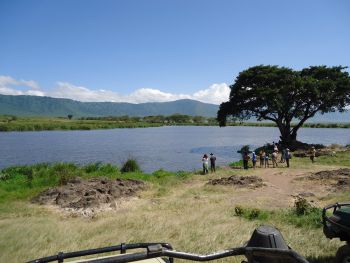 We stopped at a wooded picnic site for some lunch and as we pulled up Geitan warned us to close the roof and our windows as the Vervet Monkeys here were quite bold. Amanda and I sat in the vehicle whilst Geitan went for a walk and Wayne tucked in to a chicken leg, standing outside the vehicle. I could have only turned away for a moment, but when I looked up there was a monkey leaning across the bonnet and on to the wing mirror, just about to go for Wayne’s chicken. When I shouted to him, Wayne at first thought I was joking, but realising the note of urgency in my voice he moved quickly and was just in time to avoid what would probably have been a nasty bite. Needless to say, we didn’t linger much longer here, even though a pair of Wire-tailed Swallow were nesting in the buildings. Driving on, Geitan spotted a distant pair of Black Rhino and we saw our first Yellow-throated Sandgrouse, quickly followed by another 15. Arriving at another rest stop by a small lake on the edge of the Songor Swamp we found the obligatory wallowing Hippos and c40 tourist vehicles and attendant humans with several screeching juveniles; we just stayed long enough for comfort and a photo or two of a quartering Yellow-billed Kite which flew low above our heads. As we left the crater floor we saw our second African Marsh Harrier, but no further new birds. We arrived back at the lodge at c15.00hrs and a Cinnamon-chested Bee-eater there took our day's total to 94 species.
We stopped at a wooded picnic site for some lunch and as we pulled up Geitan warned us to close the roof and our windows as the Vervet Monkeys here were quite bold. Amanda and I sat in the vehicle whilst Geitan went for a walk and Wayne tucked in to a chicken leg, standing outside the vehicle. I could have only turned away for a moment, but when I looked up there was a monkey leaning across the bonnet and on to the wing mirror, just about to go for Wayne’s chicken. When I shouted to him, Wayne at first thought I was joking, but realising the note of urgency in my voice he moved quickly and was just in time to avoid what would probably have been a nasty bite. Needless to say, we didn’t linger much longer here, even though a pair of Wire-tailed Swallow were nesting in the buildings. Driving on, Geitan spotted a distant pair of Black Rhino and we saw our first Yellow-throated Sandgrouse, quickly followed by another 15. Arriving at another rest stop by a small lake on the edge of the Songor Swamp we found the obligatory wallowing Hippos and c40 tourist vehicles and attendant humans with several screeching juveniles; we just stayed long enough for comfort and a photo or two of a quartering Yellow-billed Kite which flew low above our heads. As we left the crater floor we saw our second African Marsh Harrier, but no further new birds. We arrived back at the lodge at c15.00hrs and a Cinnamon-chested Bee-eater there took our day's total to 94 species.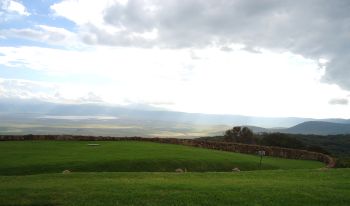
Amanda and I had dreamed of visiting the Ngorongoro for years and this was just too good an opportunity to miss: we sat down outside the lodge, looking west over the crater, with a G&T and a lemon tea and just enjoyed the view and the moment. The crater lived up to all our expectations. Back to Itinerary
Monday 27th May
We set out in thick mist at 07.00hrs this morning heading for the Serengeti National Park. As we went round the crater rim we managed to pick up a singing Red-faced Cisticola, a pair of Hunter’s Cisticola and a pair of Red-collared Widowbird. 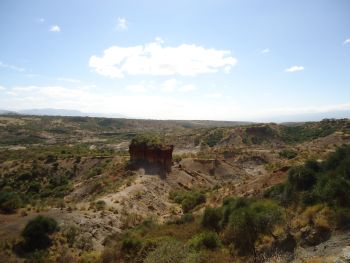 We had much better views of a pair of Dusky Turtle Dove than we had had yesterday and as we approached the road down into the crater the mist cleared and we had excellent views of a pair of Lanner as they flew around in front of us and landed on the grassy hillside. The day quickly warmed up as we moved down onto the plains where the occasional Maasai tribesman herded their goats in the arid, dusty landscape. Approaching Oldupai Gorge, a Savannah Hare darted in front of us and we saw our first Purple Roller, Red-fronted Barbet and a host of other small birds flitting about in the surrounding trees. After a talk from one of the local guides and a quick look around the small museum we continued on our way, passing an impressive flock of c45 Black-winged Lapwing before reaching the Serengeti boundary and subsequently the Naabi Hill Gate. Here we encountered a very photogenic Silverbird, Brubru and Red-throated Tit, as well as several Mwanza Flat-headed Agama, at least 6 African Grass Rat and numerous Superb and Hildebrandt’s Starling around the picnic tables.
We had much better views of a pair of Dusky Turtle Dove than we had had yesterday and as we approached the road down into the crater the mist cleared and we had excellent views of a pair of Lanner as they flew around in front of us and landed on the grassy hillside. The day quickly warmed up as we moved down onto the plains where the occasional Maasai tribesman herded their goats in the arid, dusty landscape. Approaching Oldupai Gorge, a Savannah Hare darted in front of us and we saw our first Purple Roller, Red-fronted Barbet and a host of other small birds flitting about in the surrounding trees. After a talk from one of the local guides and a quick look around the small museum we continued on our way, passing an impressive flock of c45 Black-winged Lapwing before reaching the Serengeti boundary and subsequently the Naabi Hill Gate. Here we encountered a very photogenic Silverbird, Brubru and Red-throated Tit, as well as several Mwanza Flat-headed Agama, at least 6 African Grass Rat and numerous Superb and Hildebrandt’s Starling around the picnic tables.
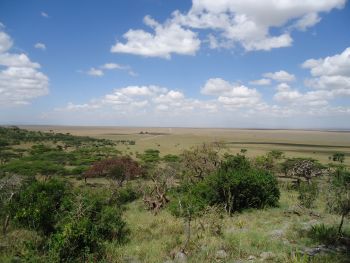 The Serengeti National Park covers an area of 14,763 square kilometres (5,700 square miles). It is located 335kilometres (208 miles) from Arusha in the south east and continues north to Kenya and borders Lake Victoria to the west. Once we entered the Serengeti, everywhere was much greener than we expected as the Wilderbeste and Zebra were still continuing their northward journey and the grasses were quite tall. As we moved further into the park towards the central Seronera area we came across a single Oribi, plus Cape Crow, a pair of Greater Kestrel, White-bellied Bustard, Hooded Vulture and Rüppell’s Long-tailed Starling. The area around Seronera is essentially a border zone between the Serengeti plains to the south and east and the Serengeti woodlands which predominate to the north and along the Western Corridor. With the day being curtailed a little by our mid afternoon dash to the Seronera Wildlife Lodge we only ended up with 86 bird species, but our impressive mammal list also included 5 Lion, Olive Baboon, Vervet Monkey, Black-backed Jackal, Spotted Hyena, Yellow-spotted (Bush) Hyrax, Rock Hyrax, Elephant, Warthog, Maasai Giraffe, c10 Coke’s Hartebeest (Kongoni), c8 Topi, Impala, Thomson’s and Grant’s Gazelle, plus a single Yellow-winged Bat around the lodge in the evening. Back to Itinerary
The Serengeti National Park covers an area of 14,763 square kilometres (5,700 square miles). It is located 335kilometres (208 miles) from Arusha in the south east and continues north to Kenya and borders Lake Victoria to the west. Once we entered the Serengeti, everywhere was much greener than we expected as the Wilderbeste and Zebra were still continuing their northward journey and the grasses were quite tall. As we moved further into the park towards the central Seronera area we came across a single Oribi, plus Cape Crow, a pair of Greater Kestrel, White-bellied Bustard, Hooded Vulture and Rüppell’s Long-tailed Starling. The area around Seronera is essentially a border zone between the Serengeti plains to the south and east and the Serengeti woodlands which predominate to the north and along the Western Corridor. With the day being curtailed a little by our mid afternoon dash to the Seronera Wildlife Lodge we only ended up with 86 bird species, but our impressive mammal list also included 5 Lion, Olive Baboon, Vervet Monkey, Black-backed Jackal, Spotted Hyena, Yellow-spotted (Bush) Hyrax, Rock Hyrax, Elephant, Warthog, Maasai Giraffe, c10 Coke’s Hartebeest (Kongoni), c8 Topi, Impala, Thomson’s and Grant’s Gazelle, plus a single Yellow-winged Bat around the lodge in the evening. Back to Itinerary
Tuesday 28th May
We set out just after 07.00 hrs this morning to explore the Western Corridor of the park looking for several species which are at the edge of their range here. Just east of Seronera Wildlife Lodge, near the waterhole complete with obligatory Hippo, we saw a Great Spotted Cuckoo in the roadside bushes, the first of c8 Silverbird and c4 Usambiro Barbet. Dark Chanting Goshawk came next, followed by c12 Grey-backed Fiscal, Black-lored Babbler, 2 Steel-blue Whydah and Cut-throat Finch as we approached the area of Whistling Acacia, where our next target was hopefully to be found.
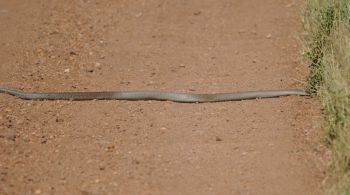 Whistling Acacia are quite numerous in some parts of the Serengeti. The tree, which can grow about 18 feet tall, but is often stunted in its growth, protects itself with pairs of thorns up to 3 inches long. Interspersed with these are modified thorns, called stipular spines, which are joined at the base by hollow bulbous swellings about 1 inch in diameter and are home to four different kinds of stinging ants. The ants are attracted to the tree because it produces a very sweet nectar and pierce these swollen thorns with tiny holes. The ants protect the tree from being grazed by swarming and biting anything that dares to touch it. If you carefully give the tree a shake, you'll see an army of little ants come out of the pods. When the wind blows it turns old and abandoned spines into tiny whistling flutes, giving the tree its name.
Whistling Acacia are quite numerous in some parts of the Serengeti. The tree, which can grow about 18 feet tall, but is often stunted in its growth, protects itself with pairs of thorns up to 3 inches long. Interspersed with these are modified thorns, called stipular spines, which are joined at the base by hollow bulbous swellings about 1 inch in diameter and are home to four different kinds of stinging ants. The ants are attracted to the tree because it produces a very sweet nectar and pierce these swollen thorns with tiny holes. The ants protect the tree from being grazed by swarming and biting anything that dares to touch it. If you carefully give the tree a shake, you'll see an army of little ants come out of the pods. When the wind blows it turns old and abandoned spines into tiny whistling flutes, giving the tree its name.
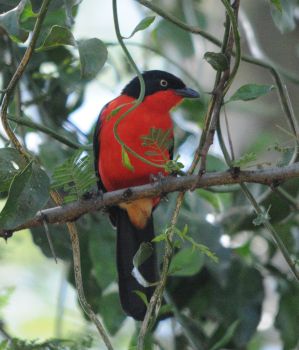 The birds we were seeking, Karamoja Apalis, responded to Wayne’s calls at once, as a pair appeared on top of one of the trees and started calling themselves. This was as well really as the area was alive with Tsetse flies: we watched the birds for as long as we could manage as the flies were everywhere inside the vehicle. Moving on quickly.......... we finally slowed down when the Whistling Acacia and the majority of the flies were well behind us. Almost immediately we spotted c4 Nyanza Swift overhead and a little behind us I noticed a Black-necked Weaver we had almost overlooked in our haste. A Black Coucal caught our attention as it flew alongside the vehicle and landed in a nearby bush and we came to a swift halt as a Black Mamba, at least 2 metres long, slithered across the road in front of us and disappeared into the roadside grass verge. After stopping for our first pair of Grey-breasted Spurfowl we moved on a short distance to a small strand of trees in a dried up streambed. Wayne had spotted some movement overhead that turned out to be a pair of stunning Black-headed Gonolek, a second lifer of the morning for him. After coming across a very confiding Long-crested Eagle perched in a roadside tree we arrived at the Grumeti River where we saw an adult and juvenile Nile Crocodile, before retracing our steps back to the Seronera area.
The birds we were seeking, Karamoja Apalis, responded to Wayne’s calls at once, as a pair appeared on top of one of the trees and started calling themselves. This was as well really as the area was alive with Tsetse flies: we watched the birds for as long as we could manage as the flies were everywhere inside the vehicle. Moving on quickly.......... we finally slowed down when the Whistling Acacia and the majority of the flies were well behind us. Almost immediately we spotted c4 Nyanza Swift overhead and a little behind us I noticed a Black-necked Weaver we had almost overlooked in our haste. A Black Coucal caught our attention as it flew alongside the vehicle and landed in a nearby bush and we came to a swift halt as a Black Mamba, at least 2 metres long, slithered across the road in front of us and disappeared into the roadside grass verge. After stopping for our first pair of Grey-breasted Spurfowl we moved on a short distance to a small strand of trees in a dried up streambed. Wayne had spotted some movement overhead that turned out to be a pair of stunning Black-headed Gonolek, a second lifer of the morning for him. After coming across a very confiding Long-crested Eagle perched in a roadside tree we arrived at the Grumeti River where we saw an adult and juvenile Nile Crocodile, before retracing our steps back to the Seronera area.
About 5 miles north of Seronera, the Seronera and Orangi Rivers converge to form a comparatively deep pool of water called the Retina Hippo Pool. Here you can park and leave the vehicle to view the hippos on foot and there are also a few shaded picnic tables. The riverbank is about 10-feet above the pool which is fenced and it is possible to walk to only a few feet away from approximately 200 Hippopotamus that inhabit the pool. We turned off the main track towards Retina Pool and found c6 Double-banded Courser and, flying all around the vehicle, c4 White-tailed Lark.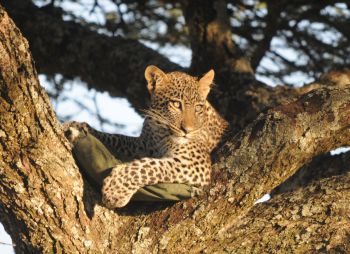 Then an obliging Harlequin Quail took off from the roadside grass and landed on the track in front of us, walked to one side and posed for the camera. As we had our lunch at the picnic site a large herd of Wildebeest began noisily crossing one of the rivers, whilst the hippos crowded cheek by jowl in the shallow waters, swishing their tails and showering themselves with the green fetid water – not a nice addition to our picnic. Returning to Seronera we drove around and stopped to admire the migrating herd of thousands of Plains Zebra and Wilderbeest and 3 Slender Mongoose. Sensing the general direction in which the vehicles around us were moving, Geitan decided three Leopards, reported earlier in the day, must have returned to the tree they had occupied. We got underway and before long found a Southern African Rock Python, sunning itself on the middle of the track. Shortly thereafter, sure enough, we found an adult and two juvenile Leopard in one of the few trees in the area and one of the youngsters was enjoying playing with a cushion from a car seat; we didn’t find out what had happened to the rest of the vehicle. After admiring the Leopards for 20 minutes as they went about their own business, almost oblivious of all the vehicles and cameras around them, we drove back towards the lodge. Our final birds of the day were a pair of Pangani Longclaw giving us a total of 104 today. Back to Itinerary
Then an obliging Harlequin Quail took off from the roadside grass and landed on the track in front of us, walked to one side and posed for the camera. As we had our lunch at the picnic site a large herd of Wildebeest began noisily crossing one of the rivers, whilst the hippos crowded cheek by jowl in the shallow waters, swishing their tails and showering themselves with the green fetid water – not a nice addition to our picnic. Returning to Seronera we drove around and stopped to admire the migrating herd of thousands of Plains Zebra and Wilderbeest and 3 Slender Mongoose. Sensing the general direction in which the vehicles around us were moving, Geitan decided three Leopards, reported earlier in the day, must have returned to the tree they had occupied. We got underway and before long found a Southern African Rock Python, sunning itself on the middle of the track. Shortly thereafter, sure enough, we found an adult and two juvenile Leopard in one of the few trees in the area and one of the youngsters was enjoying playing with a cushion from a car seat; we didn’t find out what had happened to the rest of the vehicle. After admiring the Leopards for 20 minutes as they went about their own business, almost oblivious of all the vehicles and cameras around them, we drove back towards the lodge. Our final birds of the day were a pair of Pangani Longclaw giving us a total of 104 today. Back to Itinerary
Wednesday 29th May
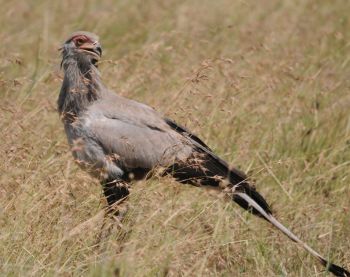 Today we set out at 06.00 for a pre-breakfast drive around the Seronera area. Within a short space of time we picked up Desert Cisticola and our second only White-bellied Bustard, Great Spotted Cuckoo and White-headed Barbet of the trip. New species continued as we saw Jacobin Cuckoo as well as Yellow-throated Longclaw. Secretarybird, (including a nest-building pair), came fast and thick: we saw 10 in total during the day. We returned to the lodge at c08.30hrs for breakfast and with only a short drive to our next lodge, we set out again at 09.30hrs, initially on the short drive to the nearby park headquarters. As we disembarked at the HQ we got our first good look at a Purple Grenadier; previously we had only seen flashes before our eyes as birds came and went in an instant. Nothing else extra special or new there, but we saw Marico Sunbird, Vitelline Weaver, Black-faced Waxbill and Bronze Mannikin amongst others. As we continued on our way we picked up the only African Wattled Lapwing of the trip and saw a Black-chested Snake Eagle before picking up speed to go through the 6 kilometre Tsetse fly infested woodland corridor leading to the Sopa Lodge. We did stop briefly as we crossed a bridge over a small stream where a Striated Heron posed lazily at the edge of the water. We arrived at the lodge at c13.00hrs and in time for a leisurely lunch on the veranda overlooking the surrounding woodland and plains. Whilst having a cold drink and waiting for lunch we spotted two much larger Mottled Swift amongst the Little Swift overhead. Around 16.00hrs we ventured out again as the day cooled down a little. We saw a single Meyer’s Parrot and both Tanzanian Red-billed and Von Der Decken’s Hornbill, side by side to give an excellent comparison between the species. Having heard birds previously, we were pleased to spot our first Klaas’s Cuckoo and we had good views again of both Long-crested Eagle and African Harrier-hawk as we meandered through more large herds of Buffalo, Zebra and Wildebeest. Other birds of note were Grey-backed Fiscal, Blue-naped Mousebird, Usambiro Barbet and Foxy Lark as we saw 106 species today. The mammal count was again good with a further 2 Lions on the plains and a single Acacia Rat plus c40 Peter’s Dwarf Epauletted Fruit Bat back at the lodge. Back to Itinerary
Today we set out at 06.00 for a pre-breakfast drive around the Seronera area. Within a short space of time we picked up Desert Cisticola and our second only White-bellied Bustard, Great Spotted Cuckoo and White-headed Barbet of the trip. New species continued as we saw Jacobin Cuckoo as well as Yellow-throated Longclaw. Secretarybird, (including a nest-building pair), came fast and thick: we saw 10 in total during the day. We returned to the lodge at c08.30hrs for breakfast and with only a short drive to our next lodge, we set out again at 09.30hrs, initially on the short drive to the nearby park headquarters. As we disembarked at the HQ we got our first good look at a Purple Grenadier; previously we had only seen flashes before our eyes as birds came and went in an instant. Nothing else extra special or new there, but we saw Marico Sunbird, Vitelline Weaver, Black-faced Waxbill and Bronze Mannikin amongst others. As we continued on our way we picked up the only African Wattled Lapwing of the trip and saw a Black-chested Snake Eagle before picking up speed to go through the 6 kilometre Tsetse fly infested woodland corridor leading to the Sopa Lodge. We did stop briefly as we crossed a bridge over a small stream where a Striated Heron posed lazily at the edge of the water. We arrived at the lodge at c13.00hrs and in time for a leisurely lunch on the veranda overlooking the surrounding woodland and plains. Whilst having a cold drink and waiting for lunch we spotted two much larger Mottled Swift amongst the Little Swift overhead. Around 16.00hrs we ventured out again as the day cooled down a little. We saw a single Meyer’s Parrot and both Tanzanian Red-billed and Von Der Decken’s Hornbill, side by side to give an excellent comparison between the species. Having heard birds previously, we were pleased to spot our first Klaas’s Cuckoo and we had good views again of both Long-crested Eagle and African Harrier-hawk as we meandered through more large herds of Buffalo, Zebra and Wildebeest. Other birds of note were Grey-backed Fiscal, Blue-naped Mousebird, Usambiro Barbet and Foxy Lark as we saw 106 species today. The mammal count was again good with a further 2 Lions on the plains and a single Acacia Rat plus c40 Peter’s Dwarf Epauletted Fruit Bat back at the lodge. Back to Itinerary
Thursday 30th May
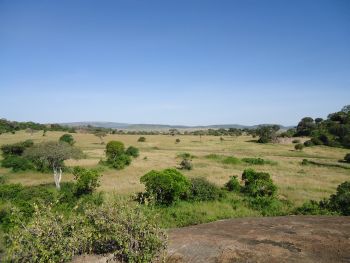 Today we set out at 06.30hrs for the area known as Moru Kopjes, a plains-woodland transition zone, situated at the mouth of the Mbalageti River Valley where an ocean of golden grasses wave in the sunlight as far as the eye can see. Smooth granite boulders rise from this sea of grass just as they have for millions of years. The Tsetse flies only seem to appear as the day warms up and even when they do, they are quite sluggish early on: we were therefore able to have a leisurely drive through the surrounding woodland as we left the lodge, but the only new bird species we saw was a pair of Green Woodhoopoe. We called once again at a nearby small lake where, amongst the flamingos, ducks and occasional wader we saw an unusually large group of between 40 & 50 Banded Mongoose. Although the grasslands were relatively quiet we spotted 3 Black-backed Jackal, a pair of White-bellied Bustard, a lone Secretarybird and Harlequin Quail as we drove along. Amanda then noticed movement on the slope of a nearby kopje and raising her bins she realised it was an adult male Lion which was silhouetted against the clear skyline – very atmospheric! We parked by the Ranger Station and ascended one of the kopjes with our picnic for an al fresco breakfast with an amazing view. As we were finishing our cups of tea a calling Klaas’s Cuckoo attracted our attention and a stunning male flew into view and landed on a nearby tree; meanwhile a Dark Chanting Goshawk flew low overhead affording good views.
Today we set out at 06.30hrs for the area known as Moru Kopjes, a plains-woodland transition zone, situated at the mouth of the Mbalageti River Valley where an ocean of golden grasses wave in the sunlight as far as the eye can see. Smooth granite boulders rise from this sea of grass just as they have for millions of years. The Tsetse flies only seem to appear as the day warms up and even when they do, they are quite sluggish early on: we were therefore able to have a leisurely drive through the surrounding woodland as we left the lodge, but the only new bird species we saw was a pair of Green Woodhoopoe. We called once again at a nearby small lake where, amongst the flamingos, ducks and occasional wader we saw an unusually large group of between 40 & 50 Banded Mongoose. Although the grasslands were relatively quiet we spotted 3 Black-backed Jackal, a pair of White-bellied Bustard, a lone Secretarybird and Harlequin Quail as we drove along. Amanda then noticed movement on the slope of a nearby kopje and raising her bins she realised it was an adult male Lion which was silhouetted against the clear skyline – very atmospheric! We parked by the Ranger Station and ascended one of the kopjes with our picnic for an al fresco breakfast with an amazing view. As we were finishing our cups of tea a calling Klaas’s Cuckoo attracted our attention and a stunning male flew into view and landed on a nearby tree; meanwhile a Dark Chanting Goshawk flew low overhead affording good views. 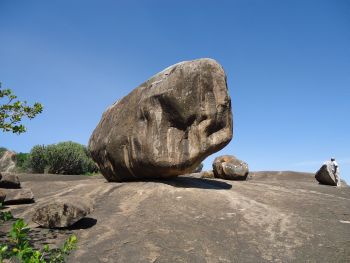 A few kilometres further on, a short walk up one of the kopjes leads to a series of Maasai paintings and a couple of hundred feet away is gong rock; this large rock has circular holes along its side that produce hollow sounds of varying pitch when struck with a small stone and may have been used as a communication device. There are also several similar smaller rocks on the kopje. Both the paintings and gong rock offer the chance for a pleasant walk and the views from the kopje are spectacular.
A few kilometres further on, a short walk up one of the kopjes leads to a series of Maasai paintings and a couple of hundred feet away is gong rock; this large rock has circular holes along its side that produce hollow sounds of varying pitch when struck with a small stone and may have been used as a communication device. There are also several similar smaller rocks on the kopje. Both the paintings and gong rock offer the chance for a pleasant walk and the views from the kopje are spectacular.
We continued on our way past several Grey-crowned Crane and Fischer’s Lovebird and found another Plain-backed Pipit, before seeing our first c8 Grey-crested Helmetshrike as we returned to the lodge for lunch. With the roosting fruit bats today we also saw Yellow-winged Bat and managed to find a solitary Senegal Galago (Lesser Bushbaby) and a stunning male Red-headed Weaver. As we enjoyed our lunch, again on the veranda, birds were much more active today and we spotted Slate-coloured Boubou, Bare-faced Go-away-bird, Holub’s Golden Weaver, African Grey Flycatcher, a pair of White-headed Vulture, c20 Mottled Swift and both Beautiful and Scarlet-chested Sunbird. We set out again at 16.00hrs for another game drive and amidst the ever present herds of Zebra and Wildebeest, Wayne spotted a lone Bat-eared Fox in the long grass – what a beauty: we had never seen one before and were both delighted. Both yesterday and today we searched the grassy plains in vain, looking for Marsh Owl but in this instance, our luck was out. We did however see a prowling young male Lion which eventually crossed the track in front of us and disappeared into the long grass. At least 12 Yellow-throated Sandgrouse flew around the vehicle at one stage, taking our daily bird species total to 83 whilst our overall list had reached 363 and we had seen 125+ lifers. By now we were struggling for new birds and it was time to move on and leave the Serengeti behind. Back to Itinerary
Friday 31st May
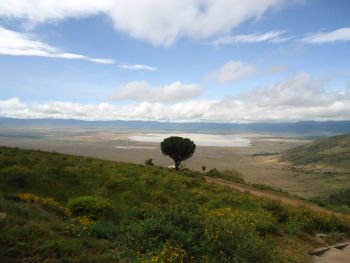 We set out today at 07.00hrs to retrace our steps out of the Serengeti and through the Ngorongoro Conservation Area to Karatu on the lower slopes of the crater. With Tsetse flies blissfully absent in the cool early morning we drove slowly through the woodland below the lodge and almost immediately Wayne heard, then spotted, Grey Penduline Tit – a lovely new bird to start the day! The previous day we had been discussing the fact that we had yet to see a Pearl-spotted Owlet. Wayne had played its call several times to attract other smaller species in woodland habitat and I had begun to doubt whether or not there were any birds in the area. Surprise, surprise! Wayne played the call again in a clearing and before any small birds appeared, an actual Pearl-spotted Owlet called in response, disproving my theory. With persistence Wayne spotted the bird in thick foliage and after another quick burst of calls it flew overhead and landed in a nearby tree – very convenient. Driving through the plains we didn’t see anything new: Cape Crow again made an appearance near the Naabi Hill Gate along with White-bellied and Kori Bustard. Rufous-tailed Weaver and White-fronted Canary also put in appearance as we were leaving the park and once again we saw White-necked Raven as we approached the crater rim, along with Cinnamon-breasted Bunting. Back at the Lodoare Gate we looked out over the valley and saw Yellow-billed Kite and Black-backed Puffback before we picked up our first Grey-capped Warbler and Brown-headed Apalis. We then travelled the short distance to Karatu and Kitela Lodge for lunch and a welcome afternoon’s rest.
We set out today at 07.00hrs to retrace our steps out of the Serengeti and through the Ngorongoro Conservation Area to Karatu on the lower slopes of the crater. With Tsetse flies blissfully absent in the cool early morning we drove slowly through the woodland below the lodge and almost immediately Wayne heard, then spotted, Grey Penduline Tit – a lovely new bird to start the day! The previous day we had been discussing the fact that we had yet to see a Pearl-spotted Owlet. Wayne had played its call several times to attract other smaller species in woodland habitat and I had begun to doubt whether or not there were any birds in the area. Surprise, surprise! Wayne played the call again in a clearing and before any small birds appeared, an actual Pearl-spotted Owlet called in response, disproving my theory. With persistence Wayne spotted the bird in thick foliage and after another quick burst of calls it flew overhead and landed in a nearby tree – very convenient. Driving through the plains we didn’t see anything new: Cape Crow again made an appearance near the Naabi Hill Gate along with White-bellied and Kori Bustard. Rufous-tailed Weaver and White-fronted Canary also put in appearance as we were leaving the park and once again we saw White-necked Raven as we approached the crater rim, along with Cinnamon-breasted Bunting. Back at the Lodoare Gate we looked out over the valley and saw Yellow-billed Kite and Black-backed Puffback before we picked up our first Grey-capped Warbler and Brown-headed Apalis. We then travelled the short distance to Karatu and Kitela Lodge for lunch and a welcome afternoon’s rest.
Although the grounds at Kitela will take time to mature, there are promising signs and the planting is beautifully done: we saw Eastern Double-collared, Yellow-bellied (Variable) and Bronzy Sunbird, Reichenow’s (Baglafecht) Weaver, Bronze Mannikin, Mourning (Schalow’s) Wheatear and Spotted Palm Thrush amongst others and ended the day with 79 species. Back to Itinerary
Saturday 1st June
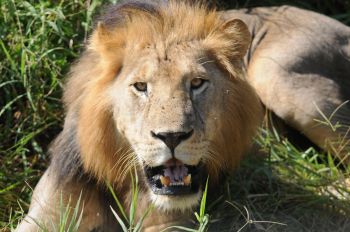 A cloudy start delayed our departure as the crater slopes were shrouded in mist. We eventually set off at 08.45hrs on the short journey, just across the road, to the Endoro River Trail which rises up towards the crater rim from a small car park just to the rear of Gibb’s Farm. We met our local guide, Charles, a football & Liverpool supporter, who also happens to be an excellent birder, at least on his own patch. Before we left the car park we saw a dashing pair of Black Sparrowhawk, one of which perched nearby. Birding on foot made a change for this trip and although woodland birding is never easy, we set off up the trail with high expectations of several new species. We soon came across a splendid White-tailed Blue Flycatcher (the first of c12 in the next 3 hours) followed by Montane White-eye, Mountain Greenbul, Tambourine Dove, Brown Woodland Warbler and a lifer from yesterday, Grey-capped Warbler. As we slowly climbed the trail up the hillside we added Black-fronted Bushshrike, Red-faced Cisticola, Brown-headed Apalis, Chinspot Batis and a cracking Narina Trogon calling softly overhead. Walking on for a while Wayne & Charles spotted movement in the dense foliage overhead and with great patience eventually located a pair of Eastern Bronze-naped Pigeon for us. A few more-common species followed before Wayne once again came up trumps as he first heard, then located a pair of Purple-throated Cuckooshrike. We had previously seen Cinnamon-chested Bee-Eater, but usually at a distance: this time we had excellent close-ups of a pair, before Yellow-bellied Waxbill, a pair of African Hill Babbler and then a Black-throated Wattle-eye grabbed our attention. We took a small detour from the main track to examine the opposite hillside and a clearing in the forest: by pure chance we were astounded when an Ayre’s Hawk Eagle drifted slowly over our heads. Continuing along the track, all was quiet for a while then a call caught Wayne’s attention: two stunning Grey-headed Nigrita came in to view and perched above us. We had previously tried the call of African Broadbill several times without any luck: as we were nearing our final destination on the trail we tried again and much to our amazement received a seemingly quite distant response. Wayne dashed in to the undergrowth and soon spotted the bird right in the middle of dense foliage. What I thought was the bird’s call was actually a noise made by its wings as it took a little hop, flew in a tight circle and returned to its perch in one swift movement. Lucky really, as this movement enabled me to quickly see the bird despite the dense cover. What an unusual little bird!
A cloudy start delayed our departure as the crater slopes were shrouded in mist. We eventually set off at 08.45hrs on the short journey, just across the road, to the Endoro River Trail which rises up towards the crater rim from a small car park just to the rear of Gibb’s Farm. We met our local guide, Charles, a football & Liverpool supporter, who also happens to be an excellent birder, at least on his own patch. Before we left the car park we saw a dashing pair of Black Sparrowhawk, one of which perched nearby. Birding on foot made a change for this trip and although woodland birding is never easy, we set off up the trail with high expectations of several new species. We soon came across a splendid White-tailed Blue Flycatcher (the first of c12 in the next 3 hours) followed by Montane White-eye, Mountain Greenbul, Tambourine Dove, Brown Woodland Warbler and a lifer from yesterday, Grey-capped Warbler. As we slowly climbed the trail up the hillside we added Black-fronted Bushshrike, Red-faced Cisticola, Brown-headed Apalis, Chinspot Batis and a cracking Narina Trogon calling softly overhead. Walking on for a while Wayne & Charles spotted movement in the dense foliage overhead and with great patience eventually located a pair of Eastern Bronze-naped Pigeon for us. A few more-common species followed before Wayne once again came up trumps as he first heard, then located a pair of Purple-throated Cuckooshrike. We had previously seen Cinnamon-chested Bee-Eater, but usually at a distance: this time we had excellent close-ups of a pair, before Yellow-bellied Waxbill, a pair of African Hill Babbler and then a Black-throated Wattle-eye grabbed our attention. We took a small detour from the main track to examine the opposite hillside and a clearing in the forest: by pure chance we were astounded when an Ayre’s Hawk Eagle drifted slowly over our heads. Continuing along the track, all was quiet for a while then a call caught Wayne’s attention: two stunning Grey-headed Nigrita came in to view and perched above us. We had previously tried the call of African Broadbill several times without any luck: as we were nearing our final destination on the trail we tried again and much to our amazement received a seemingly quite distant response. Wayne dashed in to the undergrowth and soon spotted the bird right in the middle of dense foliage. What I thought was the bird’s call was actually a noise made by its wings as it took a little hop, flew in a tight circle and returned to its perch in one swift movement. Lucky really, as this movement enabled me to quickly see the bird despite the dense cover. What an unusual little bird!
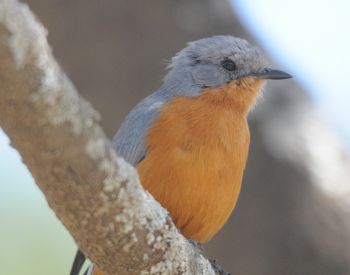 We reached our destination, the Elephant Cave, where Elephants and other mammals and birds come through the forest to a large clay lick to add the minerals in the clay to their diet. Unfortunately the “cave” is no longer: the heavy rains 6 weeks earlier had cascaded in torrents down the hillside and the cave had collapsed. New holes (mini-caves) were appearing on the reddish hillside as baboons, monkeys, Elephants et al hollowed out the earth in search of minerals. A small stream at the bottom of the valley hosted a Mountain Wagtail, while a Common Scimitarbill flitted around in the trees surrounding the clearing and a Crowned Eagle floated overhead. We started to retrace our steps back down the trail: on our way up we had seen several small guineafowl feathers on the ground, but no birds. Following a scuttling noise in the undergrowth at the side of the track we came across several quite skittish Crested Guineafowl. We must have exhausted the variety of species on our way up the hillside as we subsequently spotted nothing new on the way down. Back at the car park we spotted a Ruwenzori Montane Side-striped Chameleon clinging to an overhanging branch/vine, before heading round the corner to Gibb’s Farm for an excellent lunch. Afterwards we walked around the grounds and picked up Arrow-marked Babbler, Southern Citril and one of our main targets here, Green-headed Sunbird. We also had stunning close-ups of a Green-backed Honeybird which we had struggled to see on our second day in Arusha National Park. We returned to the lodge mid-afternoon for another relaxing few hours having only seen 61 bird species for the day, but to counter this we had added 15 species to our trip list, 13 of which were lifers, for an overall total of 383. Back to Itinerary
We reached our destination, the Elephant Cave, where Elephants and other mammals and birds come through the forest to a large clay lick to add the minerals in the clay to their diet. Unfortunately the “cave” is no longer: the heavy rains 6 weeks earlier had cascaded in torrents down the hillside and the cave had collapsed. New holes (mini-caves) were appearing on the reddish hillside as baboons, monkeys, Elephants et al hollowed out the earth in search of minerals. A small stream at the bottom of the valley hosted a Mountain Wagtail, while a Common Scimitarbill flitted around in the trees surrounding the clearing and a Crowned Eagle floated overhead. We started to retrace our steps back down the trail: on our way up we had seen several small guineafowl feathers on the ground, but no birds. Following a scuttling noise in the undergrowth at the side of the track we came across several quite skittish Crested Guineafowl. We must have exhausted the variety of species on our way up the hillside as we subsequently spotted nothing new on the way down. Back at the car park we spotted a Ruwenzori Montane Side-striped Chameleon clinging to an overhanging branch/vine, before heading round the corner to Gibb’s Farm for an excellent lunch. Afterwards we walked around the grounds and picked up Arrow-marked Babbler, Southern Citril and one of our main targets here, Green-headed Sunbird. We also had stunning close-ups of a Green-backed Honeybird which we had struggled to see on our second day in Arusha National Park. We returned to the lodge mid-afternoon for another relaxing few hours having only seen 61 bird species for the day, but to counter this we had added 15 species to our trip list, 13 of which were lifers, for an overall total of 383. Back to Itinerary
Sunday 2nd June
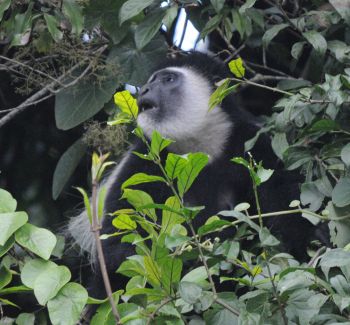 We had a lie-in today with breakfast at 08.00hrs before packing up and setting off back to Arusha and the airport. In addition to the usual species, as we drove along we spotted Tropical Boubou, Fischer’s Lovebird, Holub’s Golden Weaver, Southern Black Bishop, Black Sparrowhawk, Yellow Bishop and Rattling Cisticola. Wayne was keen to try for one final new species we had missed and seeing appropriate habitat, we stopped a little outside Karatu and played the bird’s call. For a short while there was nothing doing, then we both heard the distinctive but distant call of a Rosy-patched Bushshrike: the bird seemed to be throwing its voice as we initially struggled to locate it. Then we spotted not one, but three birds in the top of a small bush; we had excellent views of the sub-species known locally as Tsavo Bushshrike – pity they were just too far away for a decent photo as they are cracking birds. A few kilometers further along we picked up a further bonus with 3 Temminck’s Courser, another species we had previously missed. After another boneshaking drive along the A104 diversion, Wayne left us in Arusha as his flight home was two days later. Geitan dropped us off at Ngare Sero lodge in time for lunch and we had a free afternoon before our early evening flight. By mid afternoon, with boredom setting in, we went for a walk around the grounds and in addition to species we had previously seen at the lodge, we found Striated Heron, Grey-backed Cameroptera and pair of Cinnamon-chested Bee-Eater. Also new for here were 3 Guereza (Black-and-white Colobus) and an Unstriped Ground Squirrel. Only 41 bird species for the day, but this did include 2 new ones for the trip and our final lifer (Rosy-patched Bushshrike). Geitan returned at 18.00hrs to take us to the airport and as we drove, our final memories of Tanzania were stunning views of Kilimanjaro in the gathering dusk. Back to Itinerary
We had a lie-in today with breakfast at 08.00hrs before packing up and setting off back to Arusha and the airport. In addition to the usual species, as we drove along we spotted Tropical Boubou, Fischer’s Lovebird, Holub’s Golden Weaver, Southern Black Bishop, Black Sparrowhawk, Yellow Bishop and Rattling Cisticola. Wayne was keen to try for one final new species we had missed and seeing appropriate habitat, we stopped a little outside Karatu and played the bird’s call. For a short while there was nothing doing, then we both heard the distinctive but distant call of a Rosy-patched Bushshrike: the bird seemed to be throwing its voice as we initially struggled to locate it. Then we spotted not one, but three birds in the top of a small bush; we had excellent views of the sub-species known locally as Tsavo Bushshrike – pity they were just too far away for a decent photo as they are cracking birds. A few kilometers further along we picked up a further bonus with 3 Temminck’s Courser, another species we had previously missed. After another boneshaking drive along the A104 diversion, Wayne left us in Arusha as his flight home was two days later. Geitan dropped us off at Ngare Sero lodge in time for lunch and we had a free afternoon before our early evening flight. By mid afternoon, with boredom setting in, we went for a walk around the grounds and in addition to species we had previously seen at the lodge, we found Striated Heron, Grey-backed Cameroptera and pair of Cinnamon-chested Bee-Eater. Also new for here were 3 Guereza (Black-and-white Colobus) and an Unstriped Ground Squirrel. Only 41 bird species for the day, but this did include 2 new ones for the trip and our final lifer (Rosy-patched Bushshrike). Geitan returned at 18.00hrs to take us to the airport and as we drove, our final memories of Tanzania were stunning views of Kilimanjaro in the gathering dusk. Back to Itinerary
Back to Index
SUMMARY
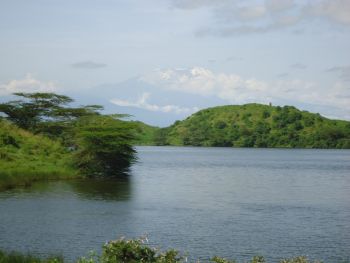 Our trip to Tanzania delivered what we expected, plus a little bit more besides. Wayne proved to be an excellent guide and with his help we saw 386 bird species, plus 2 heard only, 144 of which were lifers. As I had anticipated in the region of 100-120 this was indeed good news. In addition we saw 49 species of mammal, with the undoubted highlights being 3 Leopards and the Bat-eared Fox. Trip logistics were handled smoothly with the exception of the slight glitch on our arrival in the Serengeti. Much to our surprise, mobile phone reception was excellent almost everywhere: we live in a village surrounded by 3 large towns c6 miles away and can’t get a decent signal – here 30 miles from nowhere, signal strength was not an issue. Toilet facilities in the National Parks were also a surprise, in that, again miles from nowhere, they were clean and well maintained although standards dipped more than a little in the Serengeti. We both suffered from an upset stomach early on in the trip and in my case I must have picked up a bug as it lasted 8 days! Thanks to the aforementioned toilet facilities and careful planning, (grateful thanks to Wayne and Geitan), this did not affect our bird watching too much. Medical care is available at all Sopa Lodges and although not qualified doctors, the medic at the Serengeti Sopa quickly diagnosed my problem, gave me a course of antibiotics and, thankfully, I was cured after taking the first tablet and a good night's sleep. Apart from the wildlife, the outstanding highlights of the trip were seeing Kilimanjaro, the Serengeti plains and, most of all, the Ngorongoro crater – what a beautiful place.
Our trip to Tanzania delivered what we expected, plus a little bit more besides. Wayne proved to be an excellent guide and with his help we saw 386 bird species, plus 2 heard only, 144 of which were lifers. As I had anticipated in the region of 100-120 this was indeed good news. In addition we saw 49 species of mammal, with the undoubted highlights being 3 Leopards and the Bat-eared Fox. Trip logistics were handled smoothly with the exception of the slight glitch on our arrival in the Serengeti. Much to our surprise, mobile phone reception was excellent almost everywhere: we live in a village surrounded by 3 large towns c6 miles away and can’t get a decent signal – here 30 miles from nowhere, signal strength was not an issue. Toilet facilities in the National Parks were also a surprise, in that, again miles from nowhere, they were clean and well maintained although standards dipped more than a little in the Serengeti. We both suffered from an upset stomach early on in the trip and in my case I must have picked up a bug as it lasted 8 days! Thanks to the aforementioned toilet facilities and careful planning, (grateful thanks to Wayne and Geitan), this did not affect our bird watching too much. Medical care is available at all Sopa Lodges and although not qualified doctors, the medic at the Serengeti Sopa quickly diagnosed my problem, gave me a course of antibiotics and, thankfully, I was cured after taking the first tablet and a good night's sleep. Apart from the wildlife, the outstanding highlights of the trip were seeing Kilimanjaro, the Serengeti plains and, most of all, the Ngorongoro crater – what a beautiful place.
Bird Photos
Wildlife Photos
Trip List
Bird, Mammal and Reptile Checklist - Northern Tanzania
Bird Species Checklist - Tanzania
Maps - Northern Tanzania - Tarangire NP 1 & 2 - Ngorongoro CA - Ngorongoro Crater - Serengeti NP
David & Amanda Mason
